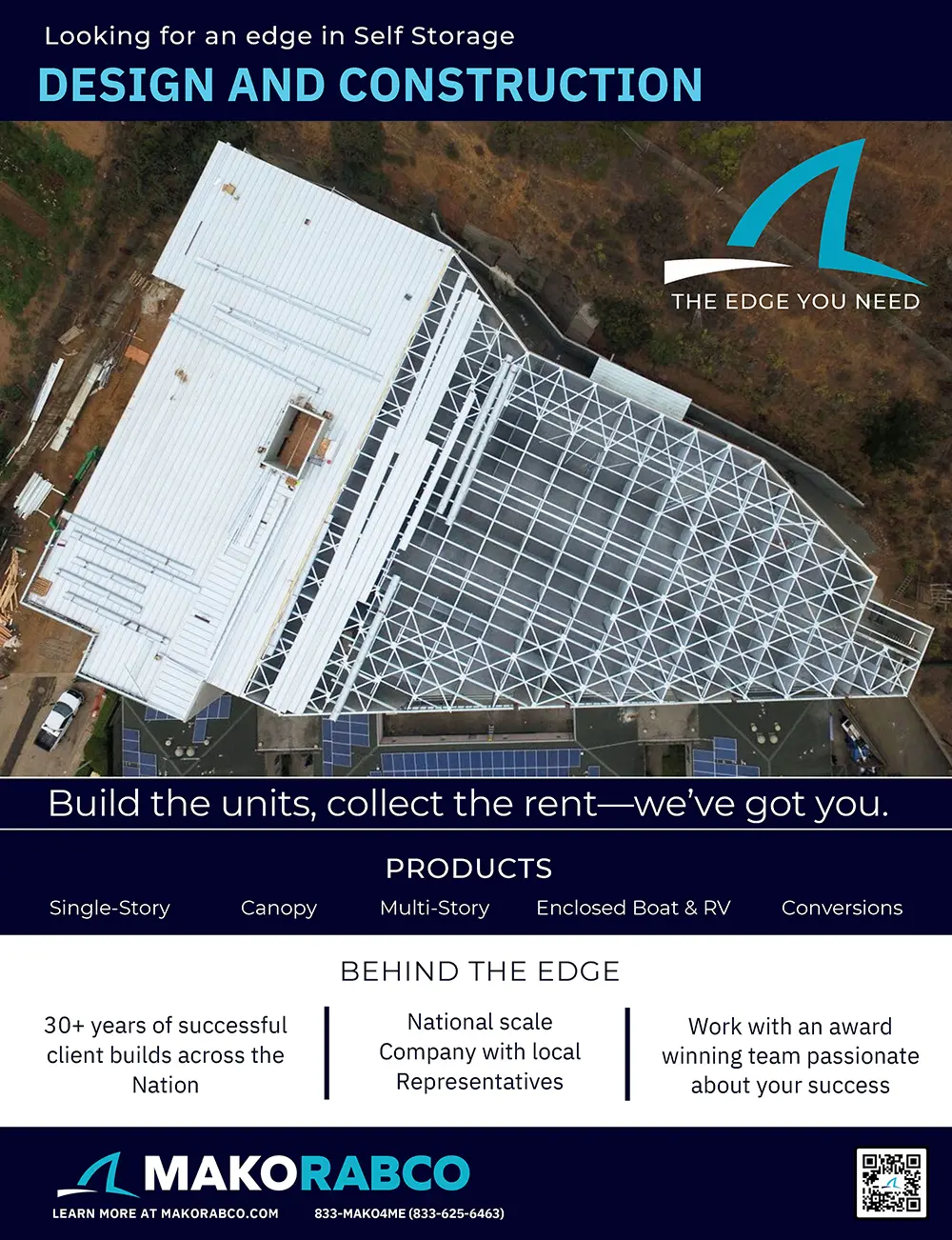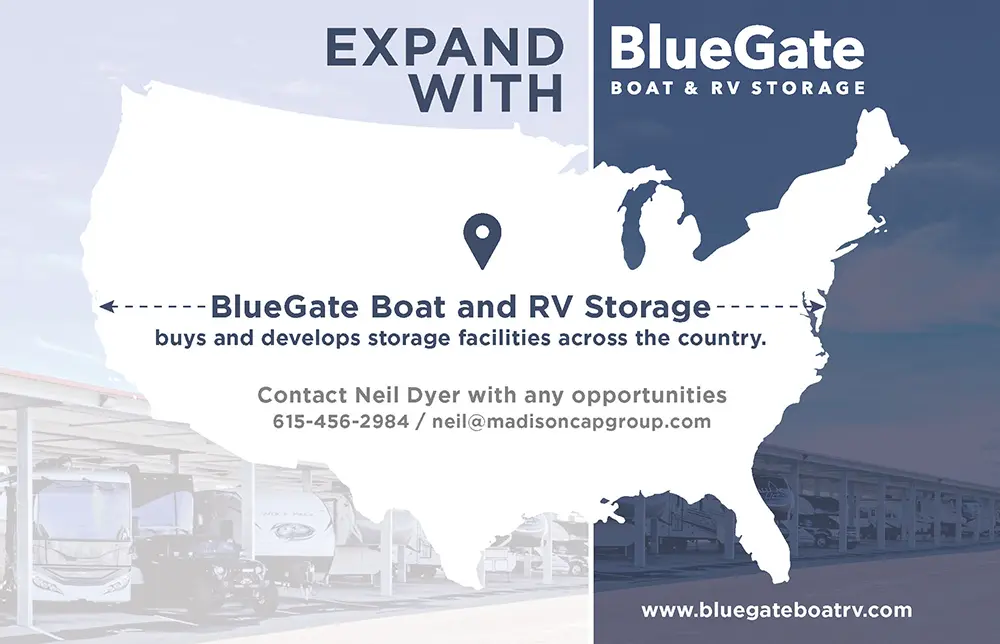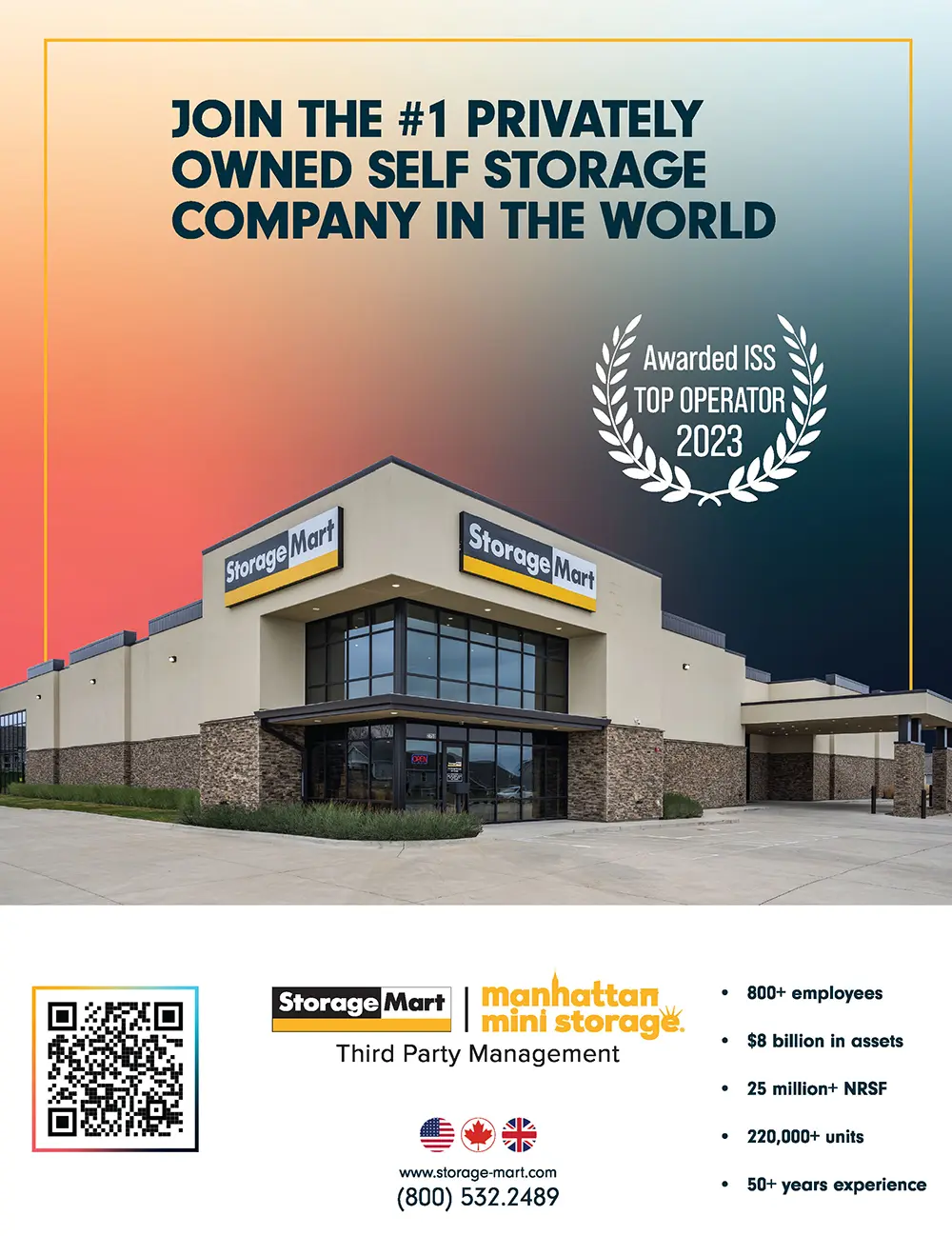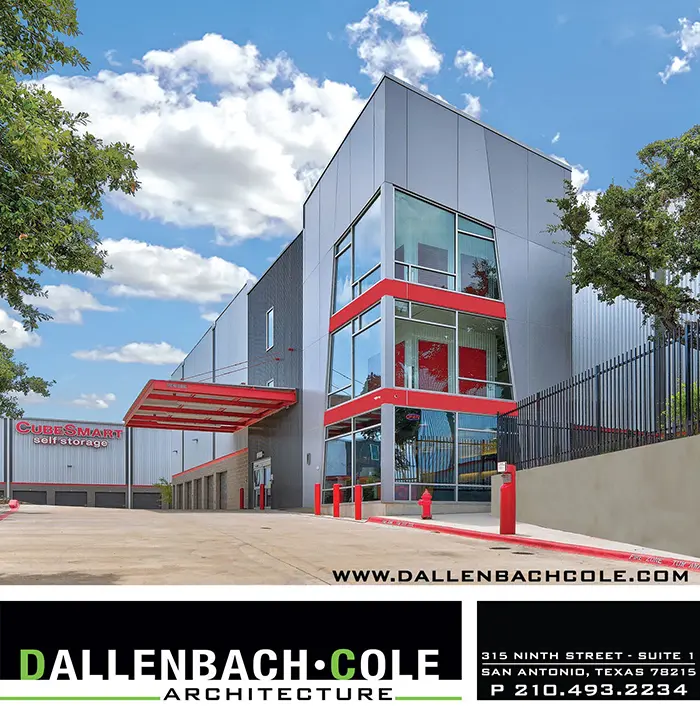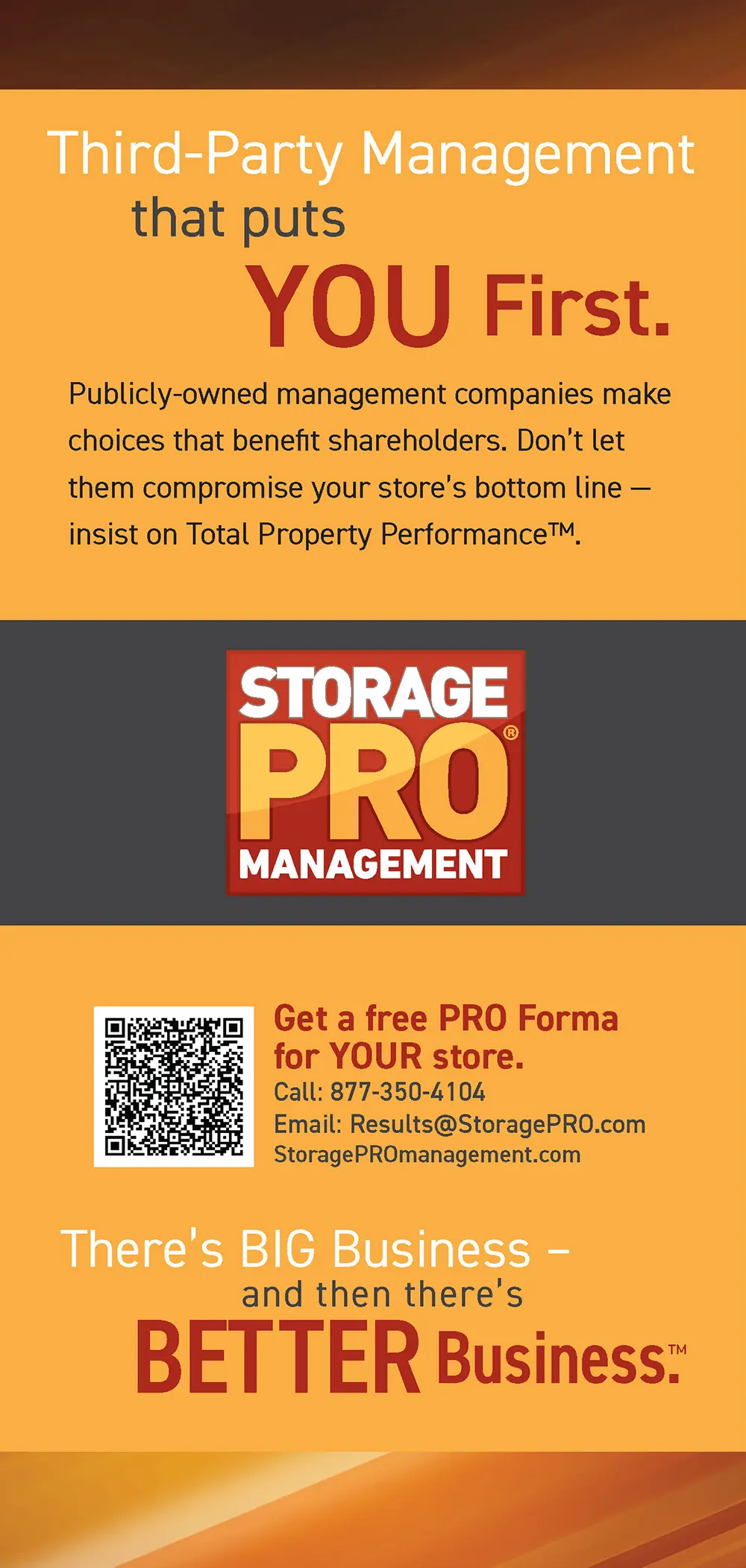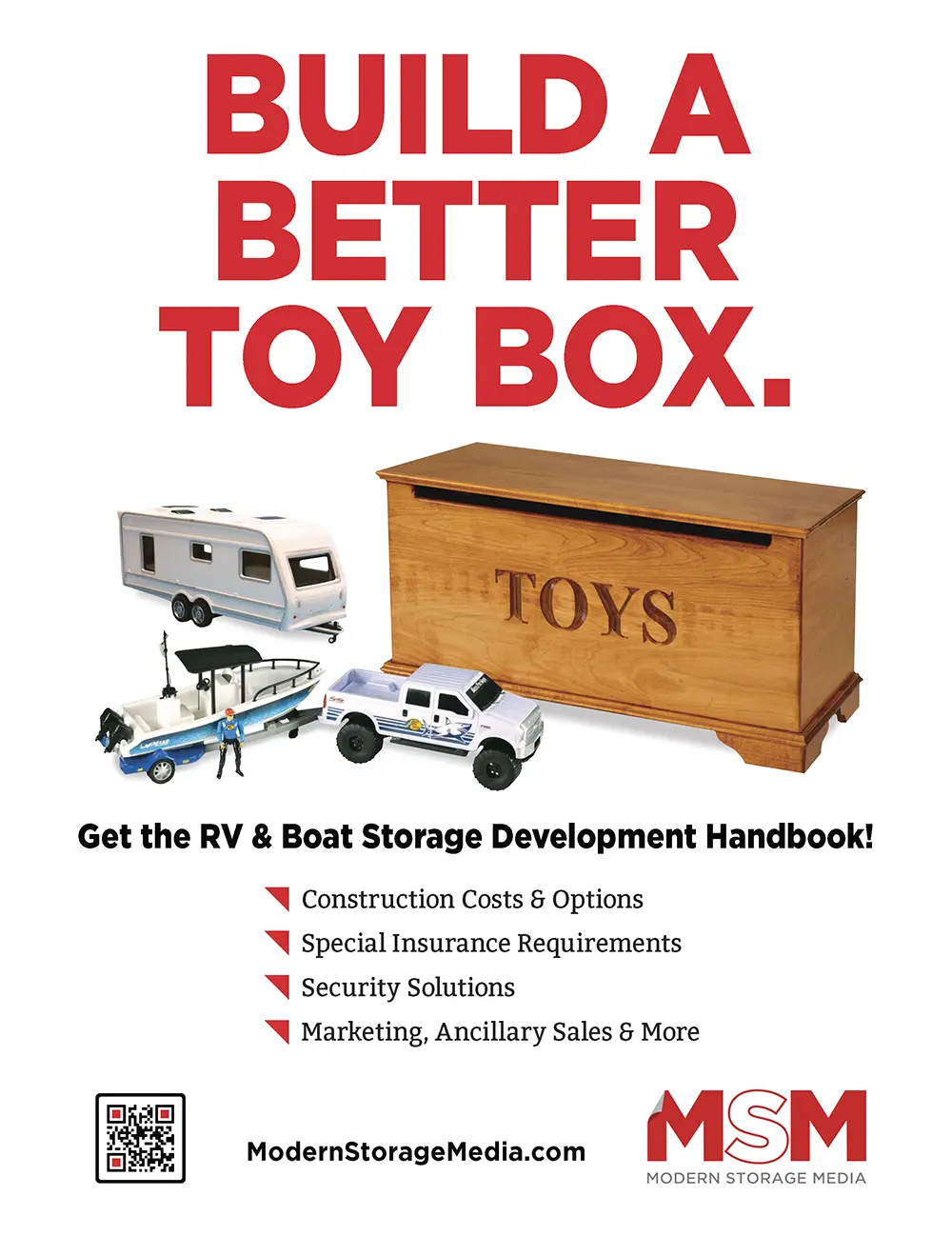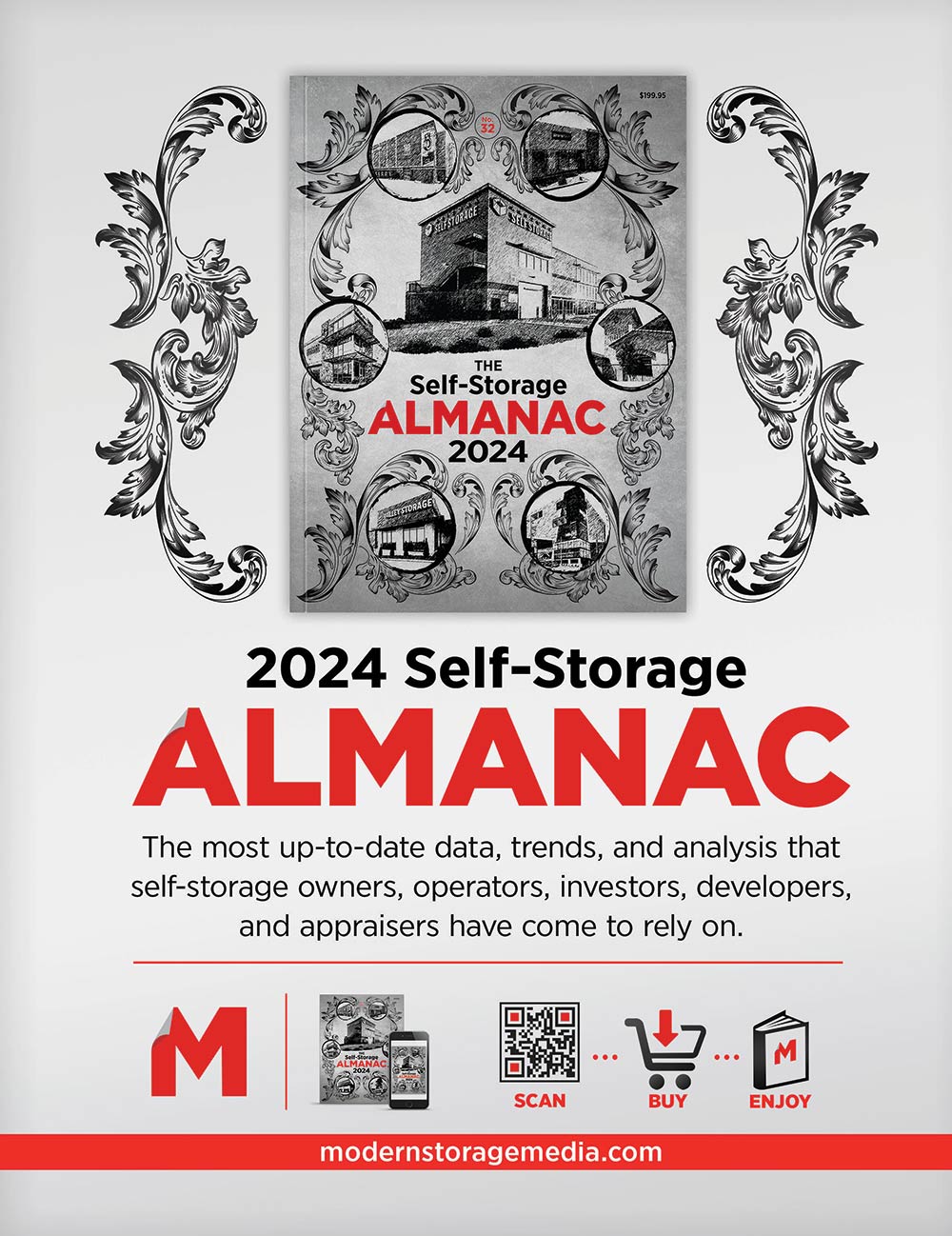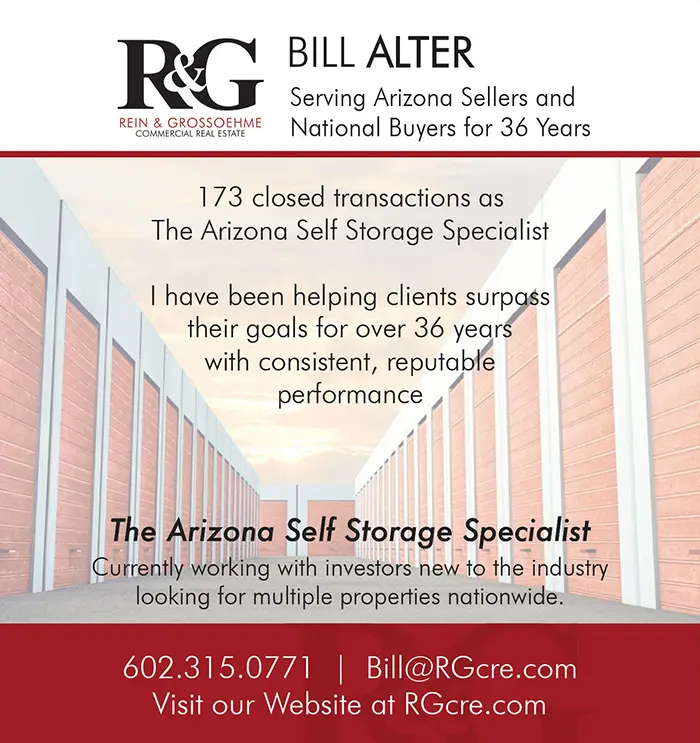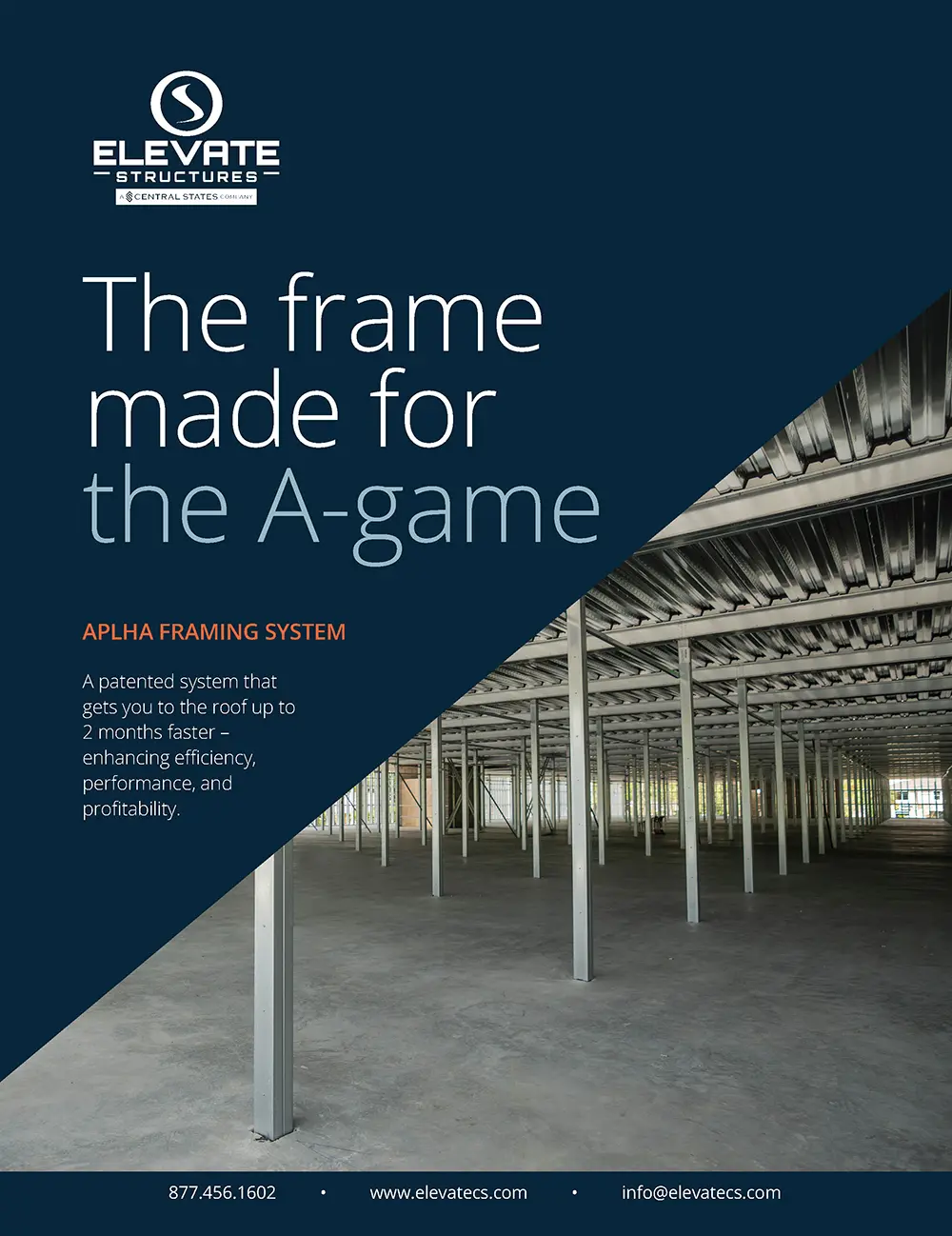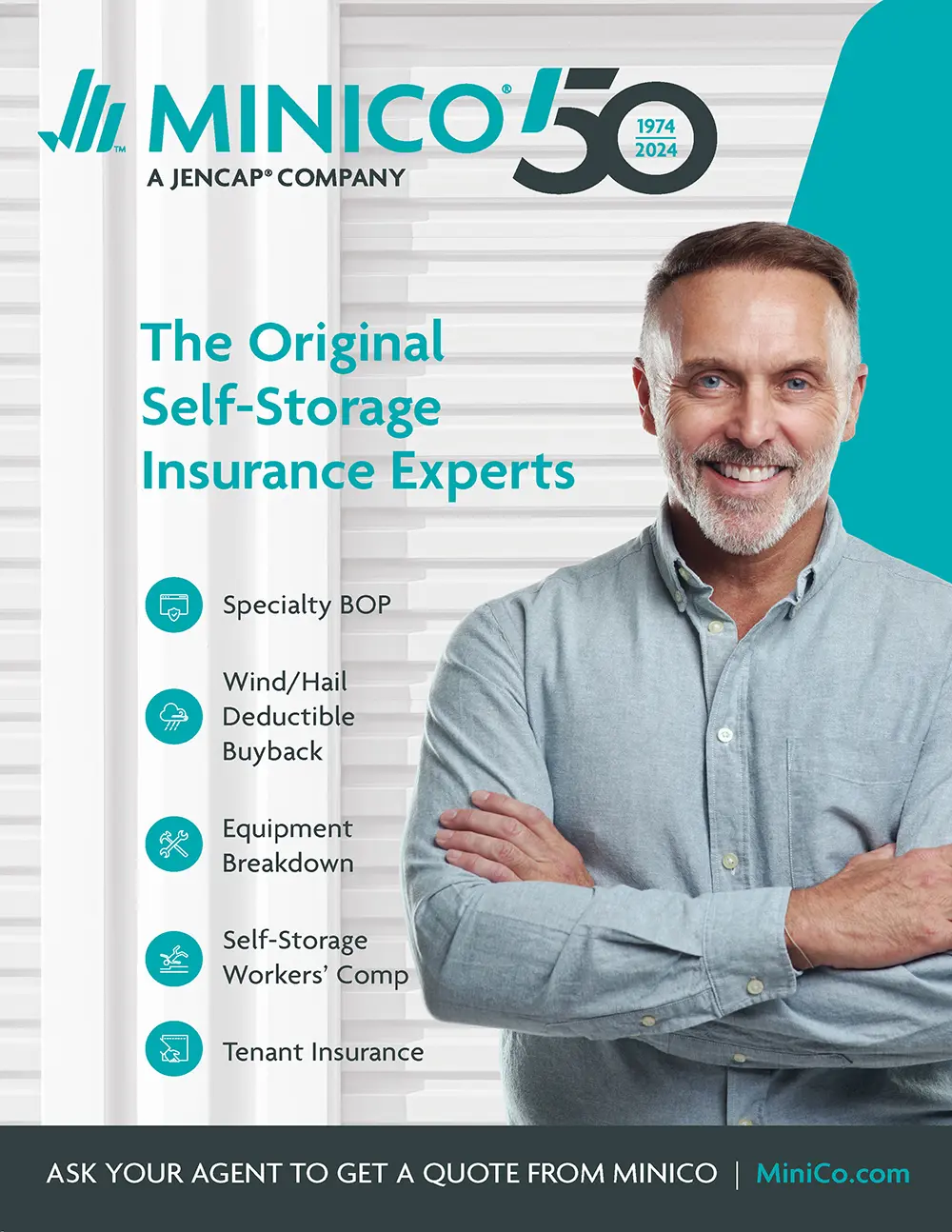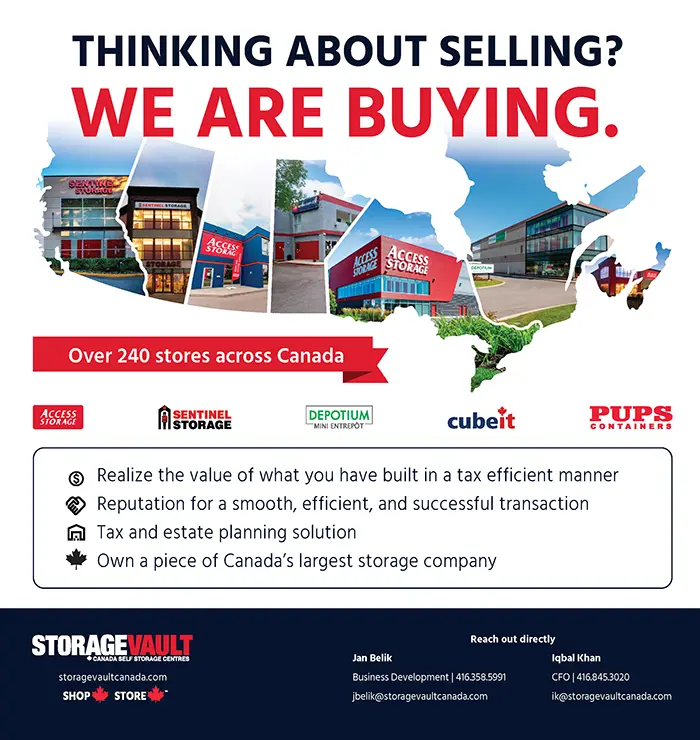How to enjoy our new magazine:
Just scroll!
Click or tap the table of contents icon in the menu bar to find any article.
Read any article by clicking or tapping the read full article button below each article intro.
Jump back to your previous browsing spot from any article using the menu bar or back to issue button.


MASS Relocatable Storage Units


-
The Benefits Of Joining Industry AssociationsPage 12
-
The Power Of Community Building For BusinessesPage 16
-
The Importance Of Curb AppealPage 20
-
Unleashing The Power Of The Professional Social Media SitePage 24
-
The 411 On Call CentersPage 28
-
Why Portable Storage Is BoomingPage 30
-
NodaFi Turns Conference Obstacle Into Golden OpportunityPage 32
-
Developers Cope With A New NormalPage 80
-
Gauging The Framework For Multilevel Storage FacilitiesPage 84
-
Havasu Riviera Marina in Lake Havasu, Ariz.Page 88
-
Choosing The Right Facility Management SoftwarePage 90
-
Four Methods For Investing In Self-StoragePage 94
-
Are Your Pricing Biases Hurting Your Bottom Line?By Brad HadfieldPage 96
- Chief Executive Opinion by Travis Morrow6
- Publisher’s Letter by Poppy Behrens9
- Meet The Team10
- Women In Self-Storage: Alyssa Quill by Erica Shatzer37
- Who’s Who In Self-Storage: James McLean by Erica Shatzer41
- StorageGives101
- Self Storage Association Update103
- The Last Word: Richard Allen104
For the latest industry news, visit our new website, ModernStorageMedia.com.
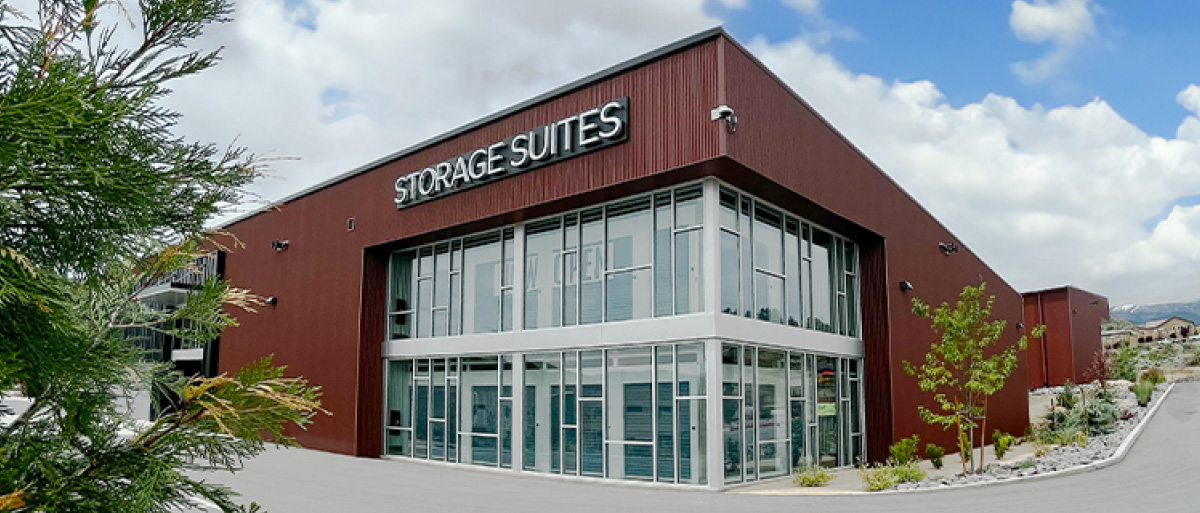


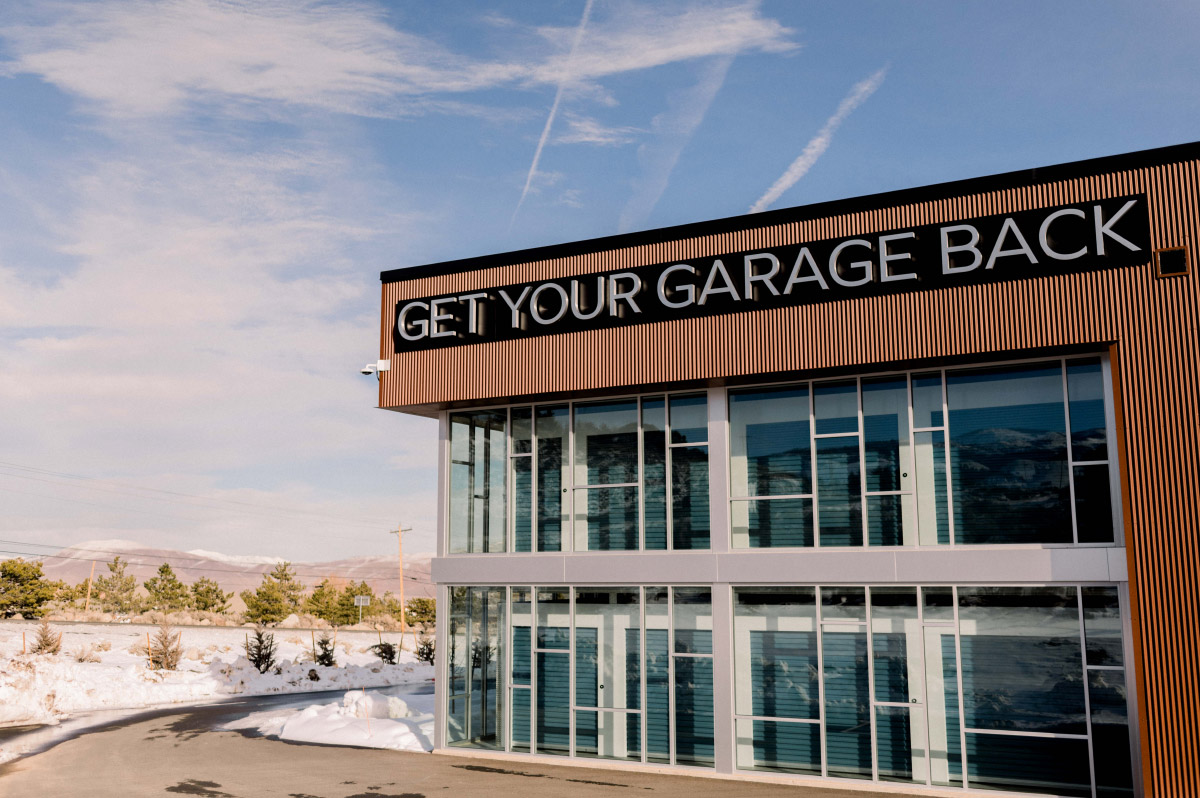
theparhamgroup.com

usiness casual has gotten more casual at conferences every year. However, you can always count on John to bring it.

He’s also the president of National Self Storage.

-
PUBLISHER
Poppy Behrens
-
Creative Director
Jim Nissen
-
Director Of Sales & Marketing
Lauri Longstrom-Henderson
(800) 824-6864 -
Circulation & Marketing Coordinator
Carlos “Los” Padilla
(800) 352-4636 -
Editor
Erica Shatzer
-
Web Manager / News Writer
Brad Hadfield
-
Storelocal® Media Corporation
Travis M. Morrow, CEO
-
MODERN STORAGE MEDIA
Jeffry Pettingill, Creative Director
-
Websites
-
Visit Messenger Online!
Visit our Self-Storage Resource Center online at
www.ModernStorageMedia.com
where you can research archived articles, sign up for a subscription, submit a change of address. 
- All correspondence and inquiries should be addressed to:
Modern Storage Media
PO Box 608
Wittmann, AZ 85361-9997
Phone: (800) 352-4636
elcome to the June edition of Messenger! In addition to all the great editorial content in this issue, we have several other items we want to share with you.
First, we are proud to announce that the 2024 RV and Boat Development Handbook—the largest ever at 112 pages—is now available for purchase. With all new content, this is the most comprehensive publication in our industry dedicated solely to the RV and boat storage sector.
From due diligence, supply and demand to construction costs, design trends, and security strategies, this development handbook has the information you need to design, build, and manage a successful RV and boat facility today. Please see here for more details. You may order a copy online or by calling (800) 352-4636.
Next, the nomination process has now officially started for the 2024 Facility of the Year campaign. For 37 years, MSM has honored the best in self-storage with this prestigious annual award. Now is the time to start thinking about your entry. The winners will be announced in the December 2024 edition of Messenger! Don’t miss out on this amazing opportunity to be recognized as the best in the industry. Each submission must be in binder format with thorough information related to the specific category criteria. For more information, please see here or email me at poppy@modernstoragemedia.com.
Last but certainly not least, please feel free to email me your thoughts, questions, or editorial suggestions for our publications. It is our goal to give you the best information possible in each monthly issue. Remember: We are here for you!
Thank you for your continued support!

Publisher

elcome to the June edition of Messenger! In addition to all the great editorial content in this issue, we have several other items we want to share with you.
First, we are proud to announce that the 2024 RV and Boat Development Handbook—the largest ever at 112 pages—is now available for purchase. With all new content, this is the most comprehensive publication in our industry dedicated solely to the RV and boat storage sector.
From due diligence, supply and demand to construction costs, design trends, and security strategies, this development handbook has the information you need to design, build, and manage a successful RV and boat facility today. Please see here for more details. You may order a copy online or by calling (800) 352-4636.

Next, the nomination process has now officially started for the 2024 Facility of the Year campaign. For 37 years, MSM has honored the best in self-storage with this prestigious annual award. Now is the time to start thinking about your entry. The winners will be announced in the December 2024 edition of Messenger! Don’t miss out on this amazing opportunity to be recognized as the best in the industry. Each submission must be in binder format with thorough information related to the specific category criteria. For more information, please see here or email me at poppy@modernstoragemedia.com.
Last but certainly not least, please feel free to email me your thoughts, questions, or editorial suggestions for our publications. It is our goal to give you the best information possible in each monthly issue. Remember: We are here for you!
Thank you for your continued support!

Publisher
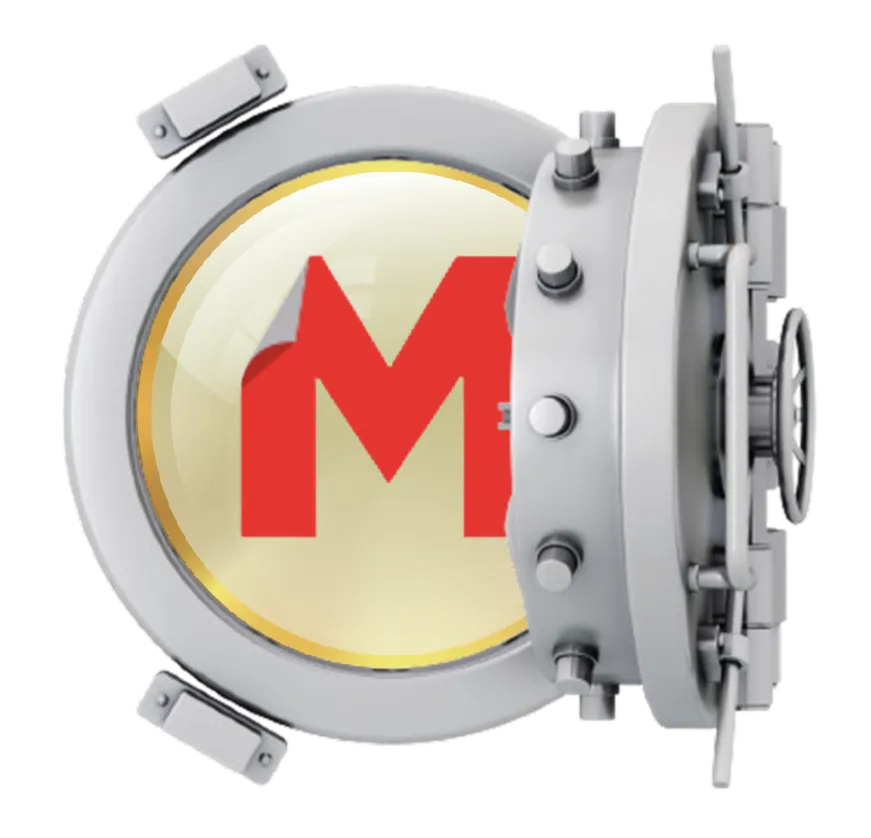
We have put every issue through 2022 on our website, giving you free access to this wealth of knowledge.




Modern Storage Media



Messenger


elen Keller is quoted as saying, “Alone we can do so little; together we can do so much.” That’s the spirit leaders at state self-storage associations think will continue to make a stronger industry.
“Our association was founded after there was a national problem with lawsuits that affected the industry,” says Amy Amideo, executive director of the Phoenix, Ariz.-based Arizona Self-Storage Association (AZSA). “Prior to that, no one wanted to work together, but there is strength in numbers.”
There is also a national Self Storage Association (SSA), but leaders at the state level say there are many benefits to belonging to both. “It’s really imperative to belong to both,” says Ross Hutchings, executive director of the California Self Storage Association (CSSA) in Sacramento, Calif. “We partner with the SSA, but we also work on issues specific to local government in California. For example, many different municipalities within the state are getting more restrictive about allowing self-storage facilities in; we’ve been seeing this more and more. Uniting our members within the state really benefits everyone.”
Working on legislative and code issues isn’t the only benefit to being a member, though. Many state associations have evolved to provide members with plenty of other services.
- To Engage
- To Educate
- To Empower
Amideo says the first principle required the association to convince members that other people within the industry (although competitors) could also help one another by working together. Once the idea started taking off, the association started reaching out to members to help educate them through seminars and workshops. Finally, the association helps empower members by hiring lobbyists to work on issues in the state important to everyone within the industry.
The CSSA was founded in 2002. “California was the biggest part of the whole western region,” says Hutchings, who added some operators decided it was time to have an association that focused on state-centric issues. The organization also emphasizes networking, education, and legislative advocacy.
Many other state associations were founded in the late 1990s and early 2000s in response to a growing industry that needed more local representation to respond to lawsuits and a patchwork of laws on the industry being written by state legislators across the country. For example, both the Missouri Self Storage Owners Association (MSSOA) and Florida Self Storage Association (FSSA) were founded in 1999. The Arkansas Self Storage Association (ARSSA) was founded in 2004.
Many state associations are taking advantage of a more digital-friendly environment, created during the COVID-19 pandemic, offering its members more opportunities to network and learn online. “New for us this year will be quarterly webinars,” says Leslie Fuqua, executive director of FSSA. Shelly Harris, executive director for both the ARSSA and MSSOA, says her organizations provide downloadable resources to members.
In between holding town halls and other digital educational events throughout the year, the AZSA holds an annual conference in the spring that draws more than 50 exhibitors. Educational seminars are presented at the conference as well. The MSSOA, ARSSA, and FSSA hold similar conventions.
In addition to presenting 24 virtual training programs last year, the CSSA holds an annual owner’s summit, in lieu of a trade show, and a separate conference in Napa that focuses on technology.
In 2019, the AZSA created an operational manual for operators. “I think it’s one of the most important things we’ve done for our members,” says Amideo. “We also created one of the first boilerplate leases.” The CSSA also has a boilerplate lease specific to the unique laws in California. “Once members pay to have it, they will receive all updates,” says Hutchings.
While many state associations are using digital technology to help inform and educate members through webinars, newsletters, and virtual town halls, Amideo says the AZSA still thinks it’s important to reach its rural membership on a one-on-one basis, especially since rural members make up about 70 percent of the AZSA membership.
“We do what we call Ruralpolooza, in which I drive across the state and talk with rural operators to introduce myself and get their perspective on issues affecting the industry,” says Amideo. “It gives us a chance to get acquainted with everyone and helps operators in rural areas feel the organization isn’t exclusively Phoenix or Tucson centric.”
For example, lien sale violations typically rank high on the list of reasons self-storage operators get sued. State associations have been able to successfully educate members on laws, as well as lobby state legislators, to clarify statutes and to eliminate or amend some of the antiquated and cumbersome laws. Both efforts help prevent mistakes that may result in lawsuits.
“We are currently working hard to get the two required newspaper notices taken out of the Florida lien law requirements,” says Fuqua. “We have a lobbyist in Tallahassee, and we held a ‘Rally in Tally’ meeting with legislators.” The FSSA provides its members with a copy of The Florida Annotated Lien Law booklet, a resource that breaks down the lien laws into layman’s terms.
Lien notification is an effort the CSSA has already worked on and won, reducing the number of notifications required from two to one. During the pandemic, the CSSA also helped lobby to keep facilities open by having self-storage considered an essential business in the state, as well as keeping members informed on states of emergency and laws passed regarding price gouging.
Many state associations offer to help find answers to legal questions, which is one of the most common things asked of the CSSA, says Hutchings.
Joining your state association supports the partnership it has with the SSA (SSA membership is separate), and it may give you access to other organizations that can provide helpful tips for your business. For example, the CSSA has a partnership with the California Employers Association to assist with human resources issues.
Membership rules and rates vary among the different state associations. For the CSSA, if an owner/operator or parent company joins, the membership includes all the facilities the company owns within California. The CSSA has about 440 owner-operator companies that represent approximately 1,700 facilities.
In most state associations, membership pricing depends on the number of facilities, allowing membership to be affordable for even a one-facility owner. The CSSA has four pricing rates for non-vendor members based on the number of facilities owned: one property, two to five facilities, six to 15 facilities, and over 15 facilities.
“Many of our larger operators benefit from the networking opportunities,” says Hutchings. “Many of the programs and educational seminars are for small to medium-sized operators. We encourage everyone to join and participate.”

n business, success is synonymous with profitability and market dominance. And sure, when people go into business, the overall goal is linked to measurable successes. But a shift is underway. Today, a company’s long-term success is also tied to the connections it has. Over the years, I have learned how important relationships are within our business. Whether it is the closeness within our team, our network of partners, our ties to the local community, or our loyal customer base, each connection matters. A strong community builds strong businesses, and a company’s product or service is only as good as its relationships.
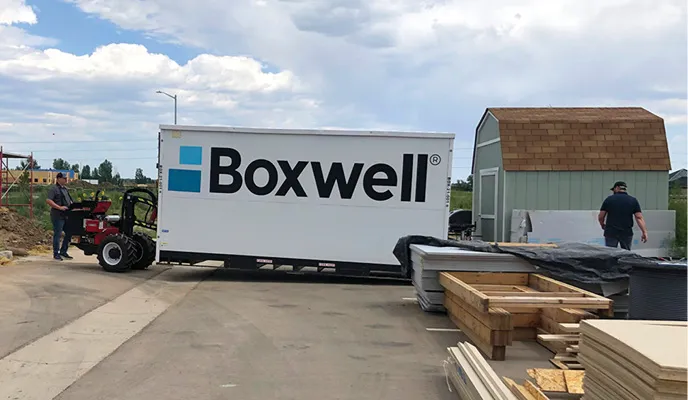


A business’ success is not determined by its profits alone. Strong connections with your team, partners, community, and customers are equally important for long-term growth and resilience. To achieve success, businesses need to look beyond the office walls. The ultimate measure of achievement is being able to find the interconnections between all your relationships. When asked what makes your business unique, remember that it’s not only about your product or service; it is also about your company culture and the relationships you build.

id you know that you only have seven seconds to make a first impression? Some suggest you have even less time. But subconsciously, your potential customers have already made their mind up about your facility before they even need storage. They have been driving by your property day in and day out, noticing your facility. When the time comes that they need storage, they either think, “There is that place on my way to work, but I would never rent there. It’s dirty and looks scary.” Or they think, “Oh! There is that place on my way to work; it looks safe and oh so convenient!” That means it is your job to make random drivers feel safe when they first see your facility, whether it is online or in person. How do you achieve this? Curb appeal! A facility that pays attention to curb appeal demonstrates a commitment to excellence and customer care, setting itself apart from competitors and potentially commanding higher rental rates. Whether your potential customer sees your facility first online or in person, you need to make it look its best for a fast “Yes!”
The first step is to improve your physical curb appeal, or how your facility looks from the street. Here are a few of the items that stand out and make a difference to your potential customers.
When customers are evaluating a property, they look at the general upkeep of the entire facility. “Clean doors, clean floors” is the mantra of most operators. What is important to a customer is that the facility is clean and well maintained. If a facility is run down and dirty, the customers do not feel safe renting and will move along to the next facility. Women make most of the decisions when it comes to storage, and one of the biggest considerations is safety. If you can’t keep up your facility, what makes your customers think you will take care of them and their belongings?
Doors are the icon of the storage industry. Some operators even use false doors on the exterior of the facility just to make clear that it is a storage facility. The public sees those doors and knows it’s self-storage, even if they have no prior experience with storage. It is imperative that you keep your doors looking top notch by keeping them clean and up to date.
Faded and chalky doors are common in the self-storage industry. The painted metal is sitting in the sun and elements day in and day out for 20, 30, 40 years. That paint is going to break down and get chalky. Do you know what that chalk is? Like dead paint, it is the topcoat from the original baked on paint that has broken down over time. Fortunately, the doors can be restored if necessary. Proper cleaning is imperative to the longevity of the doors. Think of cleaning and protecting the doors as asset preservation; doors are very expensive to replace. You want to keep that asset in service as long as possible, and you can do that with proper maintenance and occasional protection upkeep.
Flags are a staple marketing effort of most self-storage facilities; however, many are using them incorrectly. First, never put contact information on a flag. It cannot be read, especially by motorists driving by. The flag should have a very simple message, such as “Storage Here” or “We Sell Boxes.” Consider switching flags out monthly for an attention-grabbing change of scenery. Rotating the color of your flags will also bring attention to your facility.
Signage should be clearly legible from a distance; if lit, all lights should be working. You don’t want your prospects seeing SELF ___RAGE when it should be SELF STORAGE. Lights that are not well maintained make prospective customers wonder what else doesn’t work at the facility.
If your fences are falling over, have holes cut in them, or do not look secure, there is no way your tenants and prospective renters are going to think your facility is secure. Remember, security of their belongings is their No. 1 priority. All fence repairs should be taken care of immediately to reinforce the security of your property.
Well-maintained landscaping looks great, but unless maintained weekly, it can look delipidated and will take away from the clean look you are trying to achieve. Long grass and weeds, dead flowers, hedges that look like my kid’s bedhead—none of these are good looks and can happen all too fast with infrequent upkeep. Consider switching to drought-resistant landscaping: rocks, decomposed granite, succulents, or small shrubs. Not only will these types of landscaping look good with less work, but they are also cost savers in the long run. You can save money on weekly maintenance, watering, and overall upkeep.
The “broken window theory” could as easily be the “trash filled sidewalk theory,” but I guess it doesn’t have quite the ring to it. However, trash is a sneaky blight on your property that can quickly build up and become a problem. A candy wrapper here, a soda can there; before you know it, there are bags of fast food and old tires stacking up. The fact of the matter is: It’s your job to keep your property and its surroundings clean and free of trash, or people will start dumping. It doesn’t matter if the trash blows onto your property from the convenience store next door or is left by a tenant, it is your responsibility to clean it up. Keeping up on trash daily keeps your facility clean; it will also keep pests away, which will save you money on pest control as well.
Whether you have gravel or asphalt, a driveway should be easy to maneuver. All driveways should be free of potholes, puddles, and anything else that impedes access. Customers want to be able to easily drive any vehicle into the property to reach their belongings.
The biggest pet peeve of many in the storage industry is weeds in the driveways. Weeds point to ownership or management that do not care about the facility. It is simple to kill or pull weeds to keep your driveways looking fresh. A mixture of vinegar, dish soap, salt, and water will kill any weed in the driveway in just a few days. But your teams must keep this practice up to keep the driveways clean.

Cohesive Branding is a term used to describe the process of ensuring that your name, logos, colors, pictures, fonts, phone, and website formats are the same across all platforms. This includes your website, printed materials, social media, signage, online business profiles, etc. This continuity is important, as it breeds a sense of familiarity for your customers, which in turn builds trust. Trust in a storage relationship depends on stability, reliability, and security. When your property looks the same in person as it does online, that is the first step in building trust for your customers. This is one tip that helps you compete with the REITs; they are known for consistency, and you should be too. You don’t have to have a big name and shareholders to be consistently known as a familiar name in your area.
Once your facility is looking its best, it is time to get new photos to use in all your marketing avenues. This is a huge link to building trust with potential customers. For example, if you use a stock picture of a beautiful new facility on your website, but your facility looks nothing like that picture, you have already lost their trust. Not only will they wonder if they are at the right place, but they will also immediately question what other bait-and-switch tactics you have in store for them. Having up-to-date, beautiful pictures of your actual facility is very important for building that cohesive brand, which ties together the physical and digital curb appeal.
You should use these pictures to highlight all the features of your facility, especially the upgrades and basic security features that customers are seeking. Sometimes drone photography is helpful for this. With drone photography, you can show off your fully gated facility, the clean grounds, refreshed doors, camera systems, and any other areas that highlight security.
While customers shopping for storage might eventually find your website, they are going to first find it via web search. Typically, they search for “self-storage near me,” which leads them to your Google Business Profile (GBP), then on to your website. Since your GBP is often the first thing they see, this is your first chance to capture their attention and start building trust. Be sure to claim the listing (not only on Google but Apple Maps, Yelp, and any other aggregator of storage listings), and start building your profiles. Many listings are free or low cost.
It is important to ensure that all sections have complete and up-to-date information. Have you changed your office hours? Make sure you update them on your online listings. Setting expectations and clearly communicating your offerings will help your customers know how and when they can rent a unit.
The world that we live in today is vastly different from running a business a decade or more ago. Today’s consumers want to be heard and want their experiences validated. Oftentimes, this leads to them posting reviews online, which unfortunately they are more likely to do when they are upset rather than when they are happy with a service. It is important to be watchful of your online profiles and social media for negative reviews so you can respond in a positive manner.
When you receive a negative review online, you do not necessarily want to refute the facts in a public forum; but you do want to respond to each customer with contact information to resolve a problem. This shows other viewers of the review that you care and want to correct any issues.
Alternatively, while it seems redundant to respond to positive reviews, your engagement with your customers helps not only your public persona but also your SEO (search engine optimization). Search engines want to see you engaging with others in a positive light and will reward that engagement with higher search engine rankings.
In conclusion, curb appeal in self-storage is an essential aspect of facility management that can greatly influence customer choices and overall business success. By prioritizing aesthetics, safety, and convenience, self-storage facilities can create a positive and lasting impression on customers. In turn, this can lead to higher occupancy rates, increased revenue, and a stronger reputation in the market. As the self-storage industry continues to evolve, those facilities that recognize the importance of curb appeal and consistently strive to enhance it will be best positioned to thrive in an increasingly competitive landscape.

inkedIn is way more than a place for job seekers. If that’s the last time you used it, then you’re missing out on a powerful tool. Having a 100 percent completed profile with updated information, as well as a company profile page for your business, increases your trust and credibility factor immensely. It also helps establish you and your company as experts in your field or industry.
Think of LinkedIn as a global chamber of commerce on steroids. It’s more B2B (business to business) than B2C (business to consumer), but LinkedIn users are sophisticated consumers. Plus, it’s full of referral sources. LinkedIn has over 850 million members, and they continue to see record levels of engagement.
Depending on your location, a self-storage facility can have many B2B customers. Corporations may offer their relocating employees a temporary space while they find permanent homes. Smaller businesses may need to store inventory or supplies. Whatever the need, you want to take advantage of the exposure that LinkedIn offers.
This should be a professional-looking headshot so people can see your face. You wouldn’t go to a networking event with a paper bag over your head, so why wouldn’t you want to put a nice, non-fuzzy headshot on your professional LinkedIn profile? You may not be looking for a job, but you do want potential customers to buy your product or employ your services. Therefore, you need to look credible.

This should tell the visitor what you do at a glance. Make sure it’s updated and it doesn’t imply that you’re looking for a job. You have plenty of space. Use relevant keywords. In other words, generic titles like “business owner” or “facility manager” won’t help you with search engine optimization (SEO).
This should be accurate and updated. I find it frustrating when a person who I’m searching for doesn’t have their current location. If I know you’re in Phoenix, then why does it say you’re in Chicago? The internet is global, but if the person I want to connect with is in Phoenix, I want to be able to find them.
It used to be called a “summary.” It’s not your life story. It describes what you do and how you can help a potential customer. You have a lot of space, so use it. Though the space doesn’t format for bullet points, people tend to skim this section rather than read long paragraphs.
It should be current and complete. If you have a company email address, that should be there rather than the one you used when you were looking for a job (your personal email). Here you can also add your website. Choose “Other” when adding your link, and add your company name there rather than using “company website” or “personal website.” Add links to your social media profiles as well.
Again, you’re not looking for a job, but you want to come up in searches when people are searching for what you do. Think of the skills as keywords for SEO. List your talents, skills, and what you know. These are keywords that help you come up in searches. Likewise, remove the ones that are not relevant to what you’re doing now.
You can feature promos, recent blog posts, videos, articles, and special offers on your personal profile in the “Featured” section. Change it up at least once a month. This also helps with SEO.
This can be different than the one you upload to the company profile. It should reflect who you are. They recommend using an image of 1920-by-1080 pixels. If your graphic has text on it, make sure none of the text is obstructed by your picture.
By default, when you create a profile on LinkedIn, the system adds a bunch of numbers at the end of your name to make the link unique. You can get a vanity URL and make it shorter by viewing your profile and clicking the edit pen (on the right column) where it says “Public Profile & URL.” You can edit the URL, so it looks better and fits on business cards. If you have a common name, you may need to add your middle initial or something else to make it unique to you.
Use a scheduling tool like Sendible* to share content regularly. Stick to your field or industry. The idea is that people start connecting the topics you post about with your name, picture, and industry. This builds credibility. You show off what you know.
Always put a link at the bottom linking back to the original post; include “This post originally appeared on <site and link>,” as well as a call to action. This gives topical authority to your website rather than LinkedIn.
Writing for LinkedIn regularly drives traffic to your website and helps with SEO. Moreover, LinkedIn gives more visibility (AKA reach) to articles written on their platform!
To add an event to your personal profile, from the “Home” screen, look on the left towards the bottom and you’ll see “Events +.” Click on the plus sign to add your event.

By the way, just because we’re connected doesn’t mean that I’m interested in your product or service. However, if I know someone who needs something, I’m going to go to LinkedIn first and recommend someone in my network; it’s my virtual Rolodex.
Furthermore, you don’t need to accept every connection request. Check out who they are and where they’re located. Are they in your vicinity? Are they a potential referral source or customer? How will the connection benefit you? Or are they trying to sell you something? Given that, they could be a vendor.
LinkedIn will show you a list of your contacts. If it says “Invite,” that means that they are not on LinkedIn. Skip these. If they do join LinkedIn, you’ll be notified when they do. You’ll see a “Connect” button for your contacts who are on LinkedIn.
Those to whom you are connected will have a “Message” button.
Each time you go to the Network tab, LinkedIn will bring up people they think you may know based on your connections and the companies where you’ve worked. If you do know them, connect with them. The bigger your network is, the more you’ll get out of LinkedIn.
Most groups are public; others, like associations, are private and you have to be a member of the association to join. However, there are many other types of private groups. Make sure your profile is complete before you ask to join a group. The owner or moderator of the group will check you out before letting you in.
Here are some tips for posting to groups:
- Read their guidelines first! Respect their rules.
- Don’t spam them. That’s the fastest way to get kicked out.
- Share; don’t sell. Offer helpful content. Share industry or relevant news.
- Ask and answer questions. Every time you post something to the group, your picture appears next to it. This is the best way to build your trust and credibility factor as people get to know you as an expert in your field.
To create a company page, go to the top right corner and click where it says, “For Business.” At the bottom of the dropdown menu is “Create a Company Page.” Their system will walk you through setting it up. Here are some tips.
It’s a horizontal graphic. You may have to play with it a bit to make sure that it’s not cut off when you upload it and that it doesn’t look bad. This is your online image and reputation, so always use quality graphics. Taking shortcuts or using a less-than-perfect graphic makes visitors assume you provide less-than-perfect service. Using one of the many free graphics tools, you can create a banner with custom dimensions (1128-by-191 pixels). Be careful that any text on the graphic is not obstructed by your logo (400-by-400 pixels). Additionally, your branding should be consistent throughout all the social media networks and your website.
You have a lot of space to tell people about your business, so use it! Make it keyword centric. That is, use relevant keywords and phrases to help you come up not just on LinkedIn’s search engine but also on Google.
These are keywords that come up when people search for what you have to offer. Duplicate what’s in your description.
You can choose from:
- Visit Website – I don’t like this one. It’s boring. Choose one of the four options below.
- Learn More – This is more of a command that makes sense.
- Contact Us – Use this one if you have an offer in your cover graphic/banner.
- Register
- Sign Up – This is obvious, but it requires some sort of event or offer on the cover graphic.
Share other people’s related and relevant content as well as your own. Moreover, you can add the company page to a scheduling tool like Sendible* to easily share content to your page. You can also pin a promo post to the top. (Don’t forget to take it down after the promotion or event is over.) Use the free-to-a-point tool dlvr.it to auto-post your blog articles.
You can create sub-pages from your company page to highlight products and services. For instance, create a showcase page for the products you sell and any specialties you offer like RV and auto storage.
You can now write an article as your page and start a newsletter to which people can subscribe.
You can have three topical hashtags associated with your company page. Play around with them and see which ones have the greatest number of followers. Yes, people follow hashtags on LinkedIn. Use them regularly and consistently.
As I mentioned before, you can post events to your personal profile and/or to your company page. Looking at your company page as an admin, on the left you’ll see a blue “+ Create” button (Create Button image). From there you can post an event, start a post, post a job, or create an ad, newsletter, or showcase page.
Additionally, each of your employees should have their own profile linked to your facility’s page.
On the desktop, from the “Home” tab on the right, you’ll see “LinkedIn News.” Additionally, you can follow certain companies and hashtags to get the latest news. Or, use the free online news reader, Feedly.com. (That’s what I use!) The idea is the more you share news and comment on the news that’s relevant to your field or industry, the more people are going to recognize your expertise. Then, when they or a friend of theirs needs your product or service, they know who to contact. Again, it’s not who you know, it’s who your friends know!
Accept (or reject) any connection requests. Check your notifications to see if any of them are celebrating a birthday or anniversary. Browse through the list of “People You May Know” from the “My Network” tab to see if there are new people. Send connection invitations to people you met at a networking event. Invite your connections to like your business page. You get 250 “credits” or invites each month. The more you do this, the more you’ll be top of mind with your connections. However, don’t become a pest.
Check out what’s being discussed in your groups and comment on them. Post an informative article or ask a question. Invite group members to connect with you. Always respect the group’s rules and don’t over-promote.
As with all social media marketing, the more often you do it, the more you get used to the platforms and the less time it will take you to do what you need to do to effectively market your business.
Calls!

magine preparing to move and needing to rent a self-storage facility. While researching self-storage facilities, you see an online ad for one near your location. Rather than renting online, you pick up the phone and call the facility. You’re in a time crunch in the chaos of moving and calling the facility seems like the easier option.
Instead of hearing a helpful, live person answer the phone, you get an invitation to leave a voice mail; or worse, the phone just rings. It happens more often than one might expect.
According to data from OpenTech Alliance Inc., although we’re living in a digital world, 38 percent of initial contacts to a storage facility are made via telephone. Of those calls, it’s been estimated that one in three calls are not answered. If you miss that first call, Sherry Miller, business development manager for XPS Solutions in Richardson, Texas, says your chance to capture that rental drops by 52 percent. “People will simply move on to the next facility on the list.”
Apparently, the average facility misses one to three calls per day, but she once heard from a facility owner who said they were missing 40 percent of their calls. “If you’re missing calls, you’re just wasting your marketing dollars,” says Miller.
While only about 20 percent of your facility’s calls are potential new tenants, according to Miller, the other 80 percent are typically tenant related. “If you’re serving them by being available, you’re creating a good tenant experience,” she says.
That tenant experience can determine if you retain the tenant and could also determine if that tenant refers friends and family to your facility.
It is likely the smaller operators who need call centers the most. “If a facility only has one person sitting behind the desk and they have to leave the office, we know they are missing calls,” says Miller.
- You only have one person staffing your facility. Self-storage facility managers perform a variety of functions that include outside marketing, walking the property with prospective tenants, checking the property’s security and locks, and taking breaks. Sure, the manager can carry the phone with them, but if they’re with a prospective or current tenant, or off the clock for a break, they won’t answer the call. If you only have one person in the office, chances are your calls are going to voice mail if your manager isn’t available.
- You have decided to operate a facility remotely. Even remotely operated facilities need someone trained in your rental process and facility processes to help both prospective and current tenants.
- Your new rentals are declining. There could be several reasons for this, but it may be that your manager is missing calls. Reports from a fully integrated facility management software (FMS) can tell you if you’re missing calls.
- Managers have expressed that they feel overwhelmed. In addition to walking the property, managers have a variety of other responsibilities, including marketing, collections, and contacting tenants. If they feel overwhelmed taking calls on top of their other duties, a call center may increase their productivity and increase rentals.
- Your manager’s strengths lie in other areas. If you have a manager who excels in closing walk-in tenants, collections, or other managerial functions, but just isn’t adept in closing sales over the phone, your facility may benefit from a call center.
There are several companies offering call center services specific to the self-storage industry. Here are some questions you can ask if you’re thinking of hiring a call center:
- Can we keep our own telephone number? For those concerned you need a dedicated number to utilize a call center, that is no longer mandatory. Many companies that specialize in providing call center services for self-storage allow you to keep your store number. “There is no need to change anything,” says Miller.
- What kind of service do we need? There’s a variety of call services from which to choose, including allowing the call center to handle all calls or rolling over the calls only when no one is available on site. Carol Mixon, president of SkilCheck Services, Inc., in Tucson, Ariz., says most call centers can customize to your needs. “It isn’t really about which plan is most popular or requested, it’s based on the configuration of the office and staff members,” says Mixon. “The fewer employees, the more they rely on a call center for all calls and not just roll overs.”
- Although their services are fully customizable, many facilities choose a roll-over plan. “Many customers, especially those new to the industry or with a new facility, will opt for a roll-over plan,” says Scaman. “This allows any call to first ring at the facility, or directly to a manager’s or owner’s mobile phone before rolling over as a backup. Many operators choose this option for the flexibility.”
XPS Solutions has a variety of stores that choose a roll-over plan and stores that choose to allow all calls to go to the call center. “We have one property that told us we close 90 percent of all their sales calls,” says Miller. “We do everything for the property.”
Depending on the company, your company or managers may also be able to listen to calls that are rolling to the call center as well.
- How do call centers keep each individual store straight? How are the call center representatives trained for each store? The self-storage call centers mentioned in this article have rigorous training programs. “As a dedicated call center for over 15 years, our counselors undergo rigorous training programs to handle customers from different facilities effectively,” says Scaman. OpenTech’s training program begins with industry insight. “Our training begins with an in-depth exploration of the self-storage industry,” he says. “New employees gain a comprehensive understanding of industry terminology, common customer inquiries, and the unique challenges faced by self-storage facilities.” Training is then followed up with site-specific training and training in technology.
XPS Solutions provides 40 hours of comprehensive training before agents even take a phone call. All the centers also train specifically in providing good customer service. SkilCheck agents must be able to build rapport quickly and assess the customer’s needs. “They must treat each customer as if they were managing that facility in person,” says Mixon.
- How do I track call center results? All of these call center experts say they provide their clients with comprehensive data to assess results. “Our agents even help with marketing efforts, determining how the prospect learned of the facility,” says Miller.
No matter the size of your facility, if you know your facility is missing calls, employing a call center will likely improve your occupancy and sales numbers.
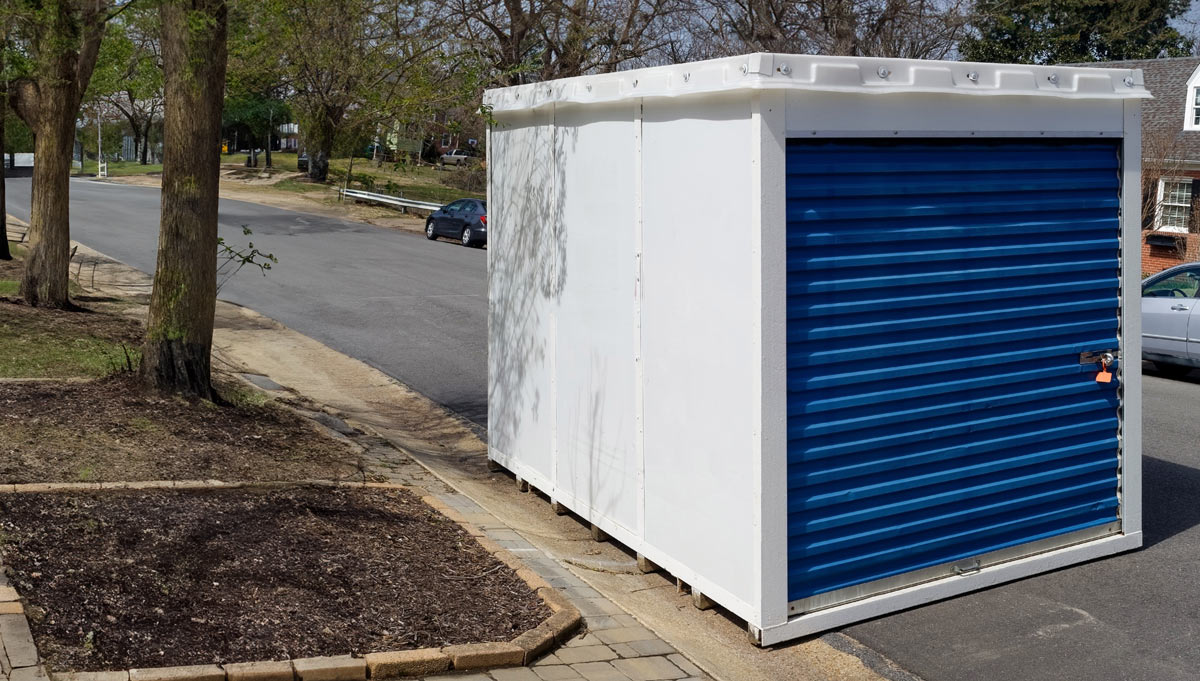
Storage
or decades, Americans have increasingly relied on storage solutions to manage their growing need for extra space. Warehouses with rows of identical units have become familiar sights, offering a convenient solution for people needing to store extra belongings. However, in today’s dynamic and ever-demanding world, a new breed of storage is transforming the industry–one that is more adaptable, efficient, and customer-centric. This is the world of portable storage, and it’s changing the way people think about storing their belongings.
Comparatively, portable storage offers a level of flexibility and convenience that traditional storage facilities simply cannot match. Secure, weatherproof containers are delivered directly to your location, eliminating the burden of transportation and allowing you to store your belongings precisely where you need them. This is an absolute game-changer for a variety of situations.
- Urban Living – Living in the city often comes with a premium on space. Portable containers can be conveniently delivered to your driveway or designated curbside location, eliminating the need to navigate through city traffic to a distant storage facility.
- Renovation Projects – Are you undergoing a home renovation? Portable containers can be delivered and placed right on your property, providing convenient on-site storage for furniture, appliances, and building materials. This keeps your project organized and allows for easy access to storage throughout the renovation process.
- Seasonal Businesses – Do you own a business that experiences seasonal fluctuations in inventory? Portable storage offers a cost-effective way to store seasonal items during off-peak months. Simply place the container on your property or a nearby lot, ensuring your valuable inventory is secure and readily accessible when the season picks back up.
- Remote Operations – Maybe your storage needs fall outside the confines of a traditional town or city. Portable containers can be delivered to remote locations, providing secure storage for construction equipment, seasonal supplies for cabins or vacation homes, or even overflow inventory for businesses operating in less populated areas.
- Security – Portable storage containers are typically constructed from industrial-grade steel, offering long-term outdoor protection from weather and theft for your belongings.
- Convenience – Many portable storage companies deliver and pick up containers directly at your chosen location, eliminating the need to rent a truck or trailer. This saves you time, money, and hassle.
- Variety Of Sizes – Portable storage companies typically offer a range of container sizes, from small to large, ensuring you can find the best fit for your storage needs.
- Precise Placement – Many portable storage companies have efficient delivery systems that require minimal clearance on your property, allowing for more precise placement compared to traditional storage facilities.

odaFi is a modern computerized maintenance management system (CMMS) “that empowers businesses to confidently and easily manage thousands of assets across numerous facilities at maximum efficiency, reducing costs and improving safety,” according to their company’s website. They provide a modern, cloud-based platform that makes facility management feasible. When keeping track of maintenance, it’s easy to lose sight of menial, trivial tasks that may seem insignificant on an individual level but can cause a larger impact if left to build over time. NodaFi has created a system that tracks miniscule maintenance tasks, necessary reparations, etc., henceforth, upkeeping a sustainable budget that mitigates necessity for large-scale repairs in the long run.
As NodaFi makes their way into the facility management circle, they naturally wanted to attend the ISS World Expo in Las Vegas. Trade shows provide the opportunity to advertise and promote one’s company through booths and sponsorships. When NodaFi arrived at the conclusion and could not secure a booth at the trade show, they began to devise a creative approach to get to the conference, make themselves as visible as possible, and reach potential clients and partners. Jacob Pandl, NodaFi’s founder and CEO, mentions they wanted “to get out there and have a successful conference.”
After some deliberation, they decided to take a different approach to advertise their company. Rather than resigning themselves to a low-key presence, they transformed an obstacle into an opportunity by offering a unique service for the conference: They provided transportation, shuttling attendees to the venue while advertising their company through the complimentary rides.
The mode of transportation chosen was a Tesla cybertruck. While cybertrucks are a polarizing topic as of late, renting one for this purpose provided a great means of transportation that was also extremely attention-grabbing. Their first move was to put the NodaFi logo on the vehicle, hoping to convey their company prominently. They then quickly realized that people attending the conference would inevitably require transportation; this led to them posting an enrollment form on LinkedIn. Seizing this opportunity immediately proved to be a fruitful effort, as there were about 40 takers. Initially, the intended outcome of this shuttling proposal, as Pandl puts it, was to “meet new people and have conversations,” which is exactly what happened. This differentiated them from other vendors, as they were the only company bold enough to take such an innovative approach.
Many third-party management companies and operators within the storage industry chatted with NodaFi about their work and what it entails. Pandl described NodaFi’s goal as not only raising brand awareness but also as establishing relationships within the industry. By providing transportation, the company could engage in meaningful exchanges, learning about other businesses’ needs while showcasing their own services. This pure and utter moment of networking provided an opportunity to advertise their business while forging new, genuine connections within the industry. This whole operation not only filled a logistical need but also ensured maximum visibility for NodaFi.
During their rides, they made sure to keep the conversations casual, as they did not want to come off as overbearing with personal sales. According to Pandl, during their transportation of individuals to the conference, there were, “tons of people talking about facility operations and preventative maintenance scheduling,” which is exactly what NodaFi specializes in. By transporting attendees, NodaFi created a mobile networking platform, fostering a relaxed atmosphere conducive to discussions about facility operations and other relevant topics. Pandl says, “We were there to meet people, provide a memorable experience, and see where it led.”
Their casual, yet hopeful, approach is reflective of their mission as a company. NodaFi’s goal is to subtly make facility maintenance an easier and smoother process. Pandl describes their company as, “picking up where other PMS [payment management systems] leave off and managing and putting together solid facility operations; we’re implementing and executing that.” He further implores that the online platform provides facilities with the ability to “track the little things that you may not remember to keep track of all the time,” providing tailored solutions for facility operations and management.
The entirety of the interactions in the cybertruck generated business and notoriety for NodaFi, leading them to continue in their growth as a company. Pandl says their projected goal was to “make a big splash and get our name out there. We’re somewhat new to the space.” Networking is an extremely constructive method to expand one’s connections and clientele, which is exactly what NodaFi achieved in this case. They took a structured networking event, expanded upon it, and used it to their utmost advantage. This cutting-edge motion of theirs has, perhaps, paved a new way for companies to approach marketing, as it’s to their benefit to stand out the way they did.
NodaFi’s recent successes have put the company on a trajectory toward greater industry prominence, and they are eagerly anticipating future opportunities to continue building their brand. The company’s creative and unconventional approach to marketing at the trade show demonstrated their knack for innovation, and this momentum will be key as they look toward upcoming conferences and industry events. NodaFi recognizes that the self-storage and facility management industries are evolving, with technology playing an increasingly vital role. By staying attuned to these trends, they can tailor their marketing efforts to resonate with industry stakeholders.
The key takeaway from NodaFi’s experience is the value of creative problem-solving in marketing and networking. Instead of relying on traditional trade show tactics, they transformed a transportation service into a brand-building opportunity, leading to successful outcomes. Their forward-thinking provides a promising future for them and other companies to follow. By thinking outside the box, they not only gained attention but also established lasting connections, demonstrating that sometimes the best way to stand out is to find an unconventional path.

ork, Pa.-based Storage Asset Management (SAM) has been in business for 14 years, leading the industry as its largest independently owned third-party management company and repeatedly ranking on Messenger’s annual top operators list. SAM’s path to success was partly paved by its co-founder and CEO, Alyssa Quill, who has been an esteemed, assiduous self-storage professional for more than two decades.
Quill began her self-storage journey in 2001 in Memphis, Tenn., as a financial analyst for Storage USA. She had just started to get her feet wet when the company was acquired by GE Capital, the former financial services division of American multinational conglomerate General Electric, through its purchase of Security Capital Group in May 2002. Under new direction, Quill became a revenue manager, analyzing market trends, pricing strategies, and demand factors to maximize revenue of the 458 facilities.
Three years later, GE Capital sold Storage USA to a joint venture between Extra Space Storage and Prudential Real Estate Ventures for $2.3 billion. Through that deal, Quill was retained by Extra Space as a revenue manager. Over approximately 3.5 years with the REIT, she moved up the ranks to vice president of operations (Southeast division).

“He saw something in me that I didn’t even see in myself.”
“John Gilliland [president and CEO of IRE] was looking for someone to grow IRE’s third-party management business,” recalls Quill, who was hired to assist with its expansion. “It was a little scary,” she says about leaving Extra Space for a smaller company, “but it was exciting too.”
Although she initially felt qualified for the position, with several years of experience under her belt, she realized she was still had plenty to learn. However, under Gilliland’s guidance, she received an insider education on the “ins and outs of third-party management.”
Unfortunately, the Great Recession and tighter lending standards put a damper on IRE’s growth plans. By 2010, Gilliland was looking to sell the third-party management division of the company. And Quill, assuming that she would be out of a job, began polishing up her resume.
“He didn’t think of me as a buyer,” she says. “I didn’t even think of myself as a buyer.”
Gilliland did have someone else in mind for the 21-property management portfolio: Jay Hoke, who had been one of Quill’s co-workers at IRE. Gilliland offered the management contracts to Hoke, but starting a new company wasn’t something he was prepared to do alone. Instead, he called Quill and asked her to become his business partner.
“He saw something in me that I didn’t even see in myself,” Quill says, adding that she will be forever grateful to Hoke for recognizing her potential.
Despite her interest, Quill needed some time to discuss the opportunity with her husband. “I didn’t have the money,” she says about putting up half the purchase price. “And I didn’t consider myself an entrepreneur.”
To appease her analytical nature, she completed numerous forecast scenarios to play out the what-ifs before making a decision. Since her husband had a good job, Hoke had plenty of relevant experience, and she and Hoke had both worked with the properties’ owners through IRE, Quill didn’t let uncertainty deter her from pursuing the venture. So, the Quills determined an amount they were comfortable putting forth, Hoke matched it, they took out a loan for the remainder, and SAM was formed on May 20, 2010.
“We had time to make mistakes and absorb them. We had time to build a strong team.”
Before taking on additional management contracts, Quill implemented operational standards for SAM, such as an operations manual and various training programs, thus enabling SAM to provide more consistent and efficient customer service. She also strengthened SAM’s team by developing new departments, creating new positions, and hiring additional corporate employees. “Watching them grow has been great,” says Quill.
On top of professional maturation, the size of SAM’s team has increased exponentially, from five corporate and 30 on-property employees to more than 900 team members.
“It was a lot of work, but a lot of fun in the early years,” she says about getting SAM up and running. “I was working at the site level more then, but I still love being at the stores with managers. I think it would be fun to run my own store someday, maybe when I retire.”
Because Quill and Hoke were already familiar with the original 21 facilities, “It didn’t feel overwhelming,” she says. “We had time to make mistakes and absorb them. We had time to build a strong team.”
After the economy rebounded and lenders resumed lending for acquisitions and new developments, SAM’s management portfolio began to expand through word-of-mouth marketing and referrals from lenders and brokers, as well as existing clients who either tell other owners about SAM or hire the company to manage facilities that they add to their portfolios. By meeting and/or exceeding the expectations of its customers, SAM grew more than tenfold by its 10-year anniversary, managing 246 locations in 28 states.
About the company’s growth plan, Quill says “smart growth” was the objective. She and Hoke did not want to sacrifice SAM’s quality of service to increase in size. “Our team is active in the industry through associations and media, but we haven’t really had vendor booths at trade shows,” she says. “We wanted to keep growth at a sustainable level.”
Now in its 14th year of business, SAM has nearly doubled the number of facilities in its portfolio in four years, managing 568 self-storage facilities in 36 states and 21 mixed-use industrial parks.
SAM’s strong remote operations department, which its team has been diligently improving since its inception, is partially responsible for the significant uptick in management contracts. Per Quill, remote management has enabled SAM’s clients to purchase small facilities that they may not have purchased otherwise.
“It has opened up new acquisitions opportunities for our clients,” she says. “It has refined the playbook for smaller properties that don’t need or can’t afford on-site management. It’s taken a few years to make it excellent. We’re excited about it.”
Currently, about 200 self-storage facilities in SAM’s portfolio (35 percent) are remotely managed through an effective hub-and-spoke model or SAM’s virtual operations management option. Of those facilities, Quill says it has been a mix of facilities that have either switched from traditional on-site management to remote management or have been using remote management since opening.
As for future growth, Quill states that “there’s still plenty of room to grow” in size, diversity, technology, etc., and this applies to SAM and the self-storage industry. Fortunately, for SAM, the company’s core values already coincide with this notion: “We are committed to doing what is best for our clients, holding ourselves accountable for the results. We focus on cultivating and evolving our team. Collaborating with teammates, vendors, clients, and community to reach our goals is important to us. To drive SAM forward, we are always seeking continuous improvement. And when we have successes, we like to celebrate as a team!”
“Ninety percent of our business is in storage. It’s what we know, what we do best, and it’s treated us well,” she says. “We’re happy and things are going well.”
Quill isn’t the only one to think that SAM is on the right track. SAM was voted one of the “Best Places to Work in PA” by the Central Penn Business Journal (CPBJ) in 2020, 2021, 2022, and 2023. It also made the list of CPBJ’s Fastest Growing Companies last year.
“While we’re on the right track, we are always working on improving. Tougher times force us to refine our operations and processes and we continue to focus on quality improvement and the customer experience,” Quill says. “I am so proud of the whole SAM team and can’t wait to see and experience the future of the storage industry with my teammates and colleagues.”
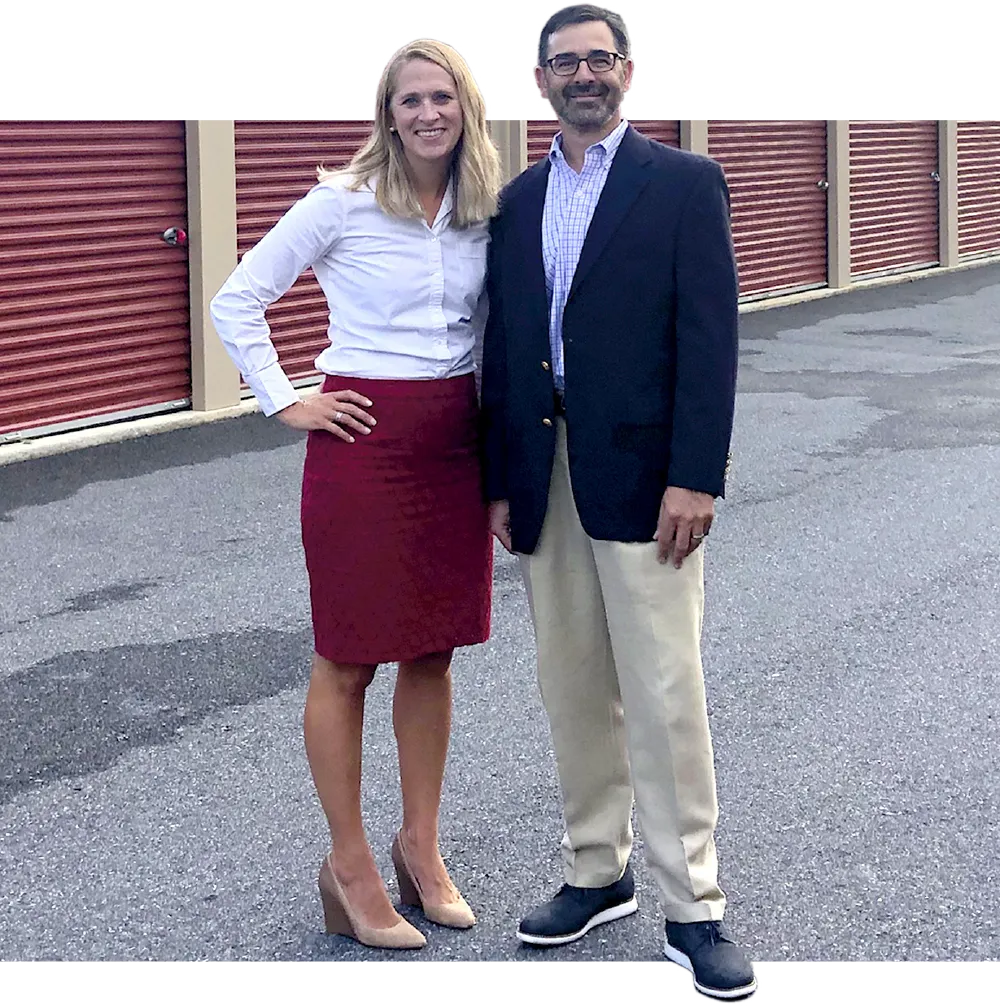
Since its inception, Storage Asset Management’s mission has been to positively impact its clients, employees, neighbors, and communities. With Quill guiding the team, SAM has been able to do that on a large scale in various ways. For instance, this past December, SAM and the facilities it manages raised funds to make a $30,000 donation to St. Jude Children’s Research Hospital for treatment and research. They also donated $10,000 to Susan G. Komen for breast cancer research and awareness after Breast Cancer Awareness Month.
“The incredible generosity exhibited by our tenants and the communities we are privileged to serve and the exceptional dedication of our SAM team members never cease to amaze me,” says Quill. “It demonstrates the impact we can all make when we work together.”
Of course, those were just two of the countless examples of the goodwill SAM has carried out. Quill has extended her altruism into the self-storage industry as well. She’s a frequent speaker at association conferences and has been on the Self Storage Association’s board of directors for five years; she currently serves as the chair. SAM is also a member of the Pennsylvania Self Storage Association and Quill was inducted into its hall of fame on May 9, 2024.

Erica Shatzer is the editor of Modern Storage Media.

or nearly a year now, the “hot talk of the town” has been the new pricing strategy employed by the REITs, according to James McLean, a market analyst for New York City-based Union Realtime, the developer of Radius+, a comprehensive site selection and location intelligence platform for self-storage and a data provider for MSM’s annual Self-Storage Almanac. The strategy, in case you haven’t heard, involves advertising rock-bottom “teaser” rates on their websites to attract customers and then significantly increasing their rates—by 50 percent or more—as soon as three months into their tenancy.
“It’s effective,” he says about the pricing strategy’s ability to bring in new customers. “Their occupancies are doing well. But is it a long-term strategy? Is it the new norm?”
Given its potential to disrupt the asset class in several ways, it’s not surprising that it remains a topic of discussion amongst industry professionals. Therefore, in this edition of “Who’s Who In Self Storage,” McLean outlines the potential perils of the REITs using this approach to pricing for an extended period of time.
“It’s a loss leader the first month,” McLean says about the heavily discounted move-in rate. “Small operators don’t or may not have the resources to do it. They aren’t going to get the same results because they aren’t playing with the same deck of cards.”
Instead of perpetuating the slippery slope of matching the lowest rates in the market, McLean encourages owner-operators and property managers to “sell something other than price.” Exceptional customer service, an easily accessible location, and amenities such as 24-hour access, drive-up access to units, climate-control options, and high-tech security features are some of the numerous selling points that could be touted to garner higher rents. As a matter of fact, according to the SSA’s 2023 Self Storage Demand Study, tenants are willing to pay extra for all those features and many others.
Otherwise, McLean offers one exception to the REITs’ pricing strategy that may generate a sigh of relief for some independent owner-operators with facilities in secondary and tertiary markets: “It’s aimed at primary markets. It’s not working as well in smaller markets,” he says, adding that Extra Space’s facilities that operate under the Northwest Self Storage brand are using a different pricing model.
Because lenders, investors, developers, appraisers, buyers, and sellers utilize rental rate data to make comparisons and decisions, and the public information found online is comprised of teaser rates instead of actual rates, it’s becoming more difficult to make accurate conclusions for underwriting, valuations, and market demand for self-storage.
Therefore, instead of simply pulling reports based on rental rate data collected from facility websites, industry players must shop the competition and use additional resources, such as MSM’s annual Self-Storage Almanac, to obtain data about the actual rates tenants are paying after the concessions lapse.
“For Radius+ it is widely business as usual, as an agnostic data provider aggregating publicly available data and sharing it with our clients,” says McLean. “However, we’ve found ourselves updating our clients on the state of the market, informing them of the new pricing strategy.”
“It’s like exploiting or capitalizing on their need for storage. Extreme ECRIs (existing customer rental increases) is where the self-storage industry’s reputation could be affected. It was typical for them to increase 20 to 40 percent in one year,” he says. “Now they are increasing 80 to 100 percent in some instances.”
McLean isn’t the only one to feel that way. Disgruntled customers across the country have been expressing their dissatisfaction with the dramatic price hikes on social media and voicing their concerns to their city council members and various media outlets—all of which could spell trouble for the entire industry, not just the REITs and the operators that have mimicked their antics. For instance, too many consumer litigation claims and/or grievances reported to government officials could result in rate caps or other regulations. Of course, those outcomes would lead to more negative press for the industry and likely compound the adverse scrutiny, which nobody wants.
“Caps on rates could be detrimental,” he says. “There has been push back. The wheels are turning.”
Although McLean acknowledges that “no one’s being held hostage,” or forced to remain a tenant, and monthly leases permit unhappy customers to move out before a rental increase goes into effect, exorbitant increases tend to leave a bad taste in customers’ mouths—regardless of whether they choose to stay and pay or part ways.
What’s more, losing a portion of customers—from excessive rental rate increases by following the REITs pricing strategy or from “promo hopping” by not matching it—is not a loss all operators can afford to absorb.
“Is there a threshold for staying? What is it?” asks McLean. “The REITs can fill back up from their funnel, but not everyone has those resources.”

- Create “explicit promos” and provide all the details to your managers. By having clear terms and conditions, managers can present customers with accurate information about their post-promo rates and let them know about future rate increases.
- Include the terms and conditions for your promos on your website and/or print promotional materials. Customers need to know from the get-go that the discounted rate isn’t permanent and that increases will occur throughout their tenancy. If you have a set schedule for ECRIs (for example, every six and 12 months), you may as well disclose the frequency. If you consistently raise rates a specific amount or percentage, post that information too.
- Develop an addendum for introductory rates and require tenants to sign it when they sign their rental agreement. The addendum should state that by signing the form the tenant acknowledges that the low rate is introductory and will eventually increase.
“People have a right to know what their monthly bill will be,” McLean says, adding that customers should be the first priority. “Maintain a level of transparency and predictability. We shouldn’t shift from the fundamentals that got the industry to this point. It’s about mutual respect, renter respect. Maintaining occupancy and trust is important.”


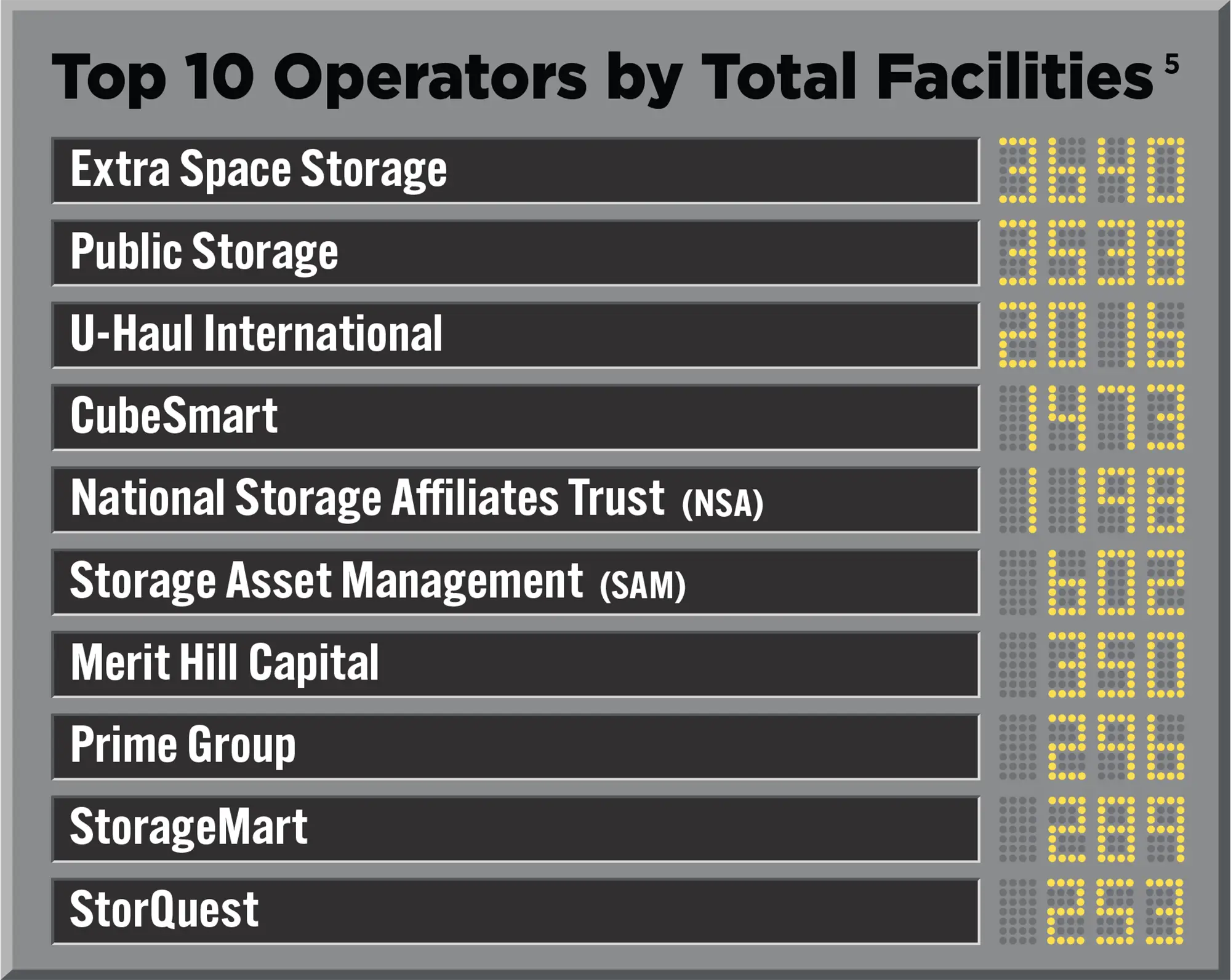


usiness decisions based on data are superior to those based on a gut feeling or intuition. The latter can point you in the right direction, but only the data can help you pinpoint the answers you need. But how do you find it? And when you do, how do you know it’s accurate? Is it fact, or is it fake?
You can probably find data to support any point you want to make, even that the earth is flat. But what you need is accurate data to help you solve your problem. So let go of preconceived notions and ulterior motives. Find what you need—not what you want—so you don’t mislead yourself and your colleagues and ultimately lose money, along with your integrity and your stakeholders.
Next, you must know what you are seeking. Define your goal so you can formulate the right question(s).
- Business goals vary over time. Do you want to maximize revenue, maximize profit, gain market share, prepare for sale of the business, or something else?
- Facility improvement goals depend on your needs. What are your weaknesses or opportunities? Who or what is your competition?
- Market entry goals to buy or build a self-storage business depend on many factors. How much money do you have available? Do you want to buy or build? How should you run it? Where should it be located?
Having clarified your goal and formulated the most relevant questions, you can hunt for the data you need.
First published in 1992, the Self-Storage Almanac has a 32-year history of providing reliable data on every aspect of the industry. Year after year, it reports the data on a consistent set of topics relevant to any self-storage business, from how many facilities are in the U.S. to rental rates in every region, from marketing metrics to operational KPIs (key performance indicators), and more. When I entered the self-storage industry writing business plans for self-storage in Asia, the developer handed me the 2002 Self-Storage Almanac. He told me he reads it cover to cover every year. He still does, and so do I. This practice gives you an internal database, helps you recognize trends, and gives you vision to see where the market is going.
The Almanac explains its methodology throughout. For instance, 2023’s “Industry Numbers” section explains how the Almanac team worked with Newmark and Radius+ to reach a total of 51,206 facilities in the U.S. (52,301 in 2024). Many different facility counts are reported elsewhere, but only the Almanac has been counting and reporting that data in a consistent way over three decades. As the industry matures, so does the data. Publisher Poppy Behrens notes, “It is essential to understand that the past eight years have been transitional for industry data.” So, the data is getting better all the time.
The second seminal resource is the SSA’s Self Storage Demand Study. There are six studies dating back to 2005. The methodology is explained in the introduction and appendices. The 2023 study states, “More than 11,000 households and businesses were contacted and asked if they currently or recently rented a self-storage unit or planned to in the next year.” It continues, “… we did not include recent renters in the calculation of rental penetration among U.S. households.”
Like the Almanac, the SSA Self Storage Demand Study evolves over time with the consumer, society, and technology. This study is known throughout the industry for its rigor and professionalism. The 2023 study was conducted by C+R Research, specializing in qualitative and quantitative market research. The SSA’s study uses the same basic approach over time, so the data on consumer penetration is worthy of serious consideration. Since the first demand study was published in 2005, penetration has increased from 9 percent to 11.1 percent (i.e., 11.1 percent of U.S. consumers were renting self-storage when the survey was conducted).
If you Google how many Americans use self-storage, the top result is usually StorageCafé data reporting 38 percent. That’s a far cry from 11.1 percent! But what is this data reporting? StorageCafé, owned by Yardi, a commercial real estate software and data provider serving the self-storage industry (among others), ran a survey and collected 17,000 respondents. StorageCafé’s Aug. 15, 2022, blog explains, “Our findings are based on a survey that ran on the online real estate platforms rentcafe.com and propertyshark.com [both owned by Yardi] for a period of one month among 16,900 respondents in the United States.”
StorageCafé clearly indicates that it:
- Ran a survey on their platforms.
- Asked one question: Have you used or plan to use self-storage in the near future?
- Reported “Roughly 38 percent of American respondents have used or plan to use self-storage in the near future.”
The SSA’s Self Storage Demand Study reports that it:
- Contacted 11,000 households and businesses.
- Asked three questions:
- Did you use self-storage in the past five years?
- Are you using self-storage now?
- Will you use self-storage in the next 12 months?
- Reported 11.1 percent of households were renting self-storage at that time.
Both seem to report reasonable data, but they report different data.
- One measures individuals, while the other measures households.
- One includes current rentals and future intentions; the other is limited to current rentals.
- One survey appeared on commercial real estate platforms owned by the reporting company and collected responses from people who searched for and used those platforms online; the other was conducted by a professional market research company that reached out directly to households and businesses.
- One reports 38 percent; the other reports 11.1 percent.
Both interesting points, but different data! Woody Allen said it best when he modified Business Professor Aaron Levenstein’s quote: “Statistics are like a bikini. What they reveal is interesting, but what they conceal is essential.”
The warning is clear: “Be suspicious of all statistics, especially those you want to be true,” according to Dr. James McGrath in The Little Book of Big Management Wisdom. To find the data you need, always search out what is actually being reported. Drill down into what the data is based on, how it was collected, what it is reporting, and other relevant factors so you do not misinterpret it. Many bad decisions are made based on wrongly reported or misinterpreted data.
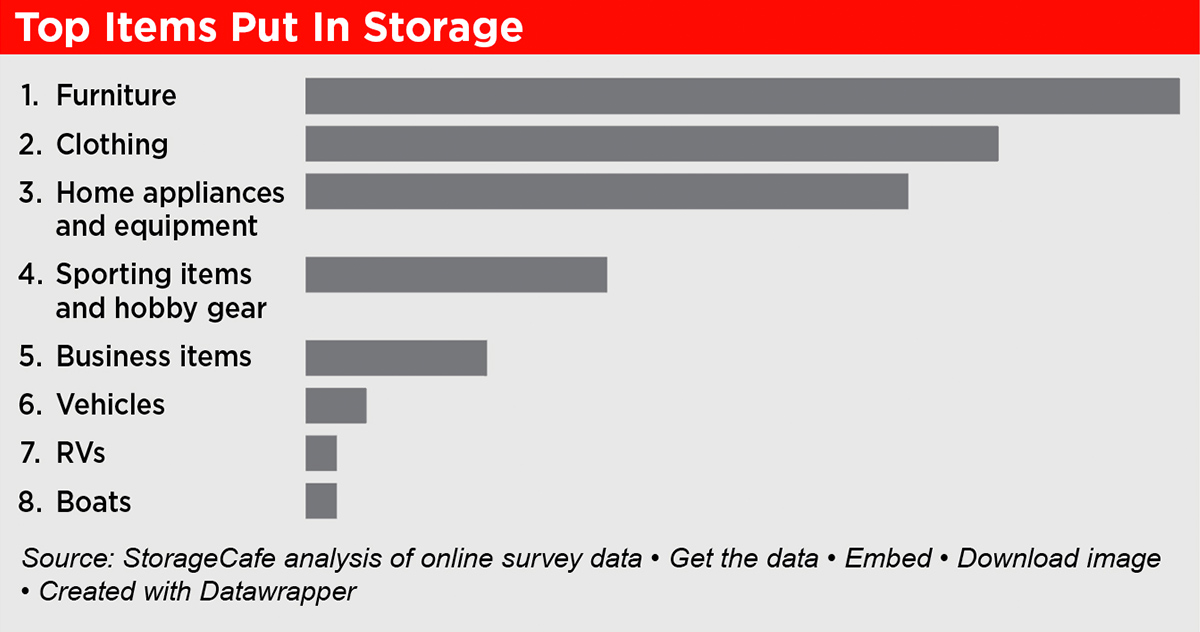
- “Get the data” enables you to download a CSV file. The image below shows how the data that generated the chart looks when opened in Excel.
- “Embed” enables you to copy the actual code so you can embed the data visualization (the chart), which is particularly helpful if you want to display it on a website. The experts say that is a good choice because it offers a more engaging, informative, and user-friendly experience, compared to static images like our screenshot. But often a simple screenshot is sufficient, especially if it is in a document such as a business plan.
- “Download image” is an even better option for a business plan. It gives you a pristine PNG file to paste into your documents, complete source citation (StorageCafé analysis of online survey data) and how it was created (by Datawrapper, an online tool to create data visualization, i.e., graphics like Chart 2), but not the other options, such as downloading the data.

If you want to design the optimal unit mix for a new development, look at your data.
- Which units generate the most revenue per square foot?
- Which size rents quickest?
- Which unit size has a waiting list?
Drill down into your reports over time (at least a full year so you can see trends) to answer these and other questions so you can design the best unit mix for your new facility.
If you want to see what marketing tactic generates the most rentals, do A/B testing. The point is, use your own data. You have more data than you think. You know how it was collected and maintained. You should be able to trust your own data more than any other source.
Then, talk to colleagues. The self-storage industry is known for its “coopetition,” Travis Morrow’s combined word for “cooperation” and “competition.” In fact, as CEO of Storelocal, Morrow is a great resource to talk to about how to drill down into your data.
Happy hunting for the data you need, carefully sorting through tempting nuggets that may not be true. It’s the best foundation for solid, successful business decisions.

icture this: It’s a brisk morning in early spring, and you’re standing outside a self-storage facility, coffee in hand, watching as customers trickle in to access their units. As the president and co-founder of Right Move Storage, I’ve found myself in this scene countless times, pondering the ever-shifting landscape of the self-storage industry. In these moments, I’m reminded of the journey that led me here—the challenges, the triumphs, and the pivotal decisions that shaped our company’s trajectory. And at the heart of every decision, there’s one constant: data.
I’ve dedicated my career to helping self-storage owners navigate the complexities of our industry. In this article, I invite you to join me on a journey through the world of data-driven decision-making in self-storage. Together, we’ll explore how harnessing the power of data has transformed not only my own approach to business but also the fortunes of countless self-storage owners like yourself. So grab your coffee, settle in, and let’s uncover the secrets to success in an industry where data reigns supreme.
As a seasoned player in the self-storage industry, we recognize the importance of comprehending its nuances and dynamics to thrive in this ever-evolving landscape. Let’s delve deeper into the core elements shaping the self-storage industry.
Growth Trends And Market Dynamics
The self-storage industry has undergone a remarkable expansion, spurred by shifting consumer behaviors, urbanization trends, and evolving lifestyles. Factors such as the rise of minimalist living and the growing need for flexible storage solutions have contributed to this growth trajectory. Understanding these underlying trends and market dynamics is paramount for self-storage operators striving to maintain a competitive edge. By dissecting the drivers propelling industry growth, we can tailor our strategies to align with emerging demands and market shifts.
Key Players And Competitors
In a crowded arena of storage providers, identifying the key players making waves is crucial for navigating the competitive landscape effectively. From multinational corporations boasting expansive networks to local mom-and-pop operations offering personalized service, the self-storage sector exhibits a diverse array of players. By scrutinizing the strategies and distinguishing features of these key players, we gain valuable insights to inform our own business approaches and carve out our niche in the market.
Challenges Faced By Operators
Operating a self-storage facility presents a myriad of challenges, ranging from managing fluctuating demand to navigating regulatory complexities. However, armed with resilience and strategic foresight, these challenges can be overcome. By acknowledging the hurdles confronting self-storage operators and proactively devising solutions, we empower ourselves to surmount obstacles and fortify our position in the industry. Whether it entails optimizing facility operations, adapting to evolving market dynamics, or ensuring compliance with regulatory standards, we approach these challenges with unwavering resolve and a data-driven mindset.
Benefits Of Data-Driven Decision-Making
Improved operational efficiency: By analyzing operational data such as occupancy rates and revenue per square foot, self-storage operators can identify inefficiencies, optimize resource allocation, and maximize revenue potential. For example, by analyzing occupancy patterns and transaction data, operators can anticipate peak demand periods and adjust staffing levels accordingly, leading to smoother operations and higher customer satisfaction. Or, by monitoring the call frequency data, an owner can understand the risk of having the manager perform duties out of the office that might cause a $1,600 rental (14- to 16-month rental opportunity) to be missed.
Enhanced customer experience: Understanding customer demographics and preferences is key to delivering a personalized and seamless experience. By collecting and analyzing customer data, operators can tailor their services to meet the unique needs of their target market, leading to higher customer satisfaction and loyalty.
Better marketing strategies: Data-driven marketing strategies enable operators to target the right audience with the right message at the right time, leading to higher conversion rates and increased ROI. By analyzing market data such as local demographics and competitor analysis, operators can identify opportunities for growth, optimize marketing spend, and drive customer acquisition.
Financial optimization: Analyzing financial data such as revenue and expenses, return on investment (ROI), and profitability allows operators to identify areas of inefficiency and waste, leading to cost savings and increased profitability. By monitoring key financial metrics and KPIs, operators can make data-driven decisions that drive long-term financial success.
Occupancy rates: Tracking occupancy rates allows operators to optimize pricing strategies, identify trends, and forecast future demand. By analyzing occupancy data over time, operators can identify patterns and adjust pricing and promotions accordingly to maximize revenue.
Revenue per square foot: Calculating revenue per square foot helps operators assess the profitability of their storage units and identify opportunities for revenue growth. By analyzing revenue per square foot by unit type, size, and location, operators can optimize pricing and unit mix to maximize profitability.
Customer demographics: Understanding customer demographics allows operators to tailor their marketing efforts and services to meet the needs of their target market. By collecting and analyzing customer demographic data, operators can identify trends, preferences, and opportunities for growth.
Market Data
Local demographics and population trends: Analyzing local demographics and population trends helps operators identify growth opportunities and target markets. By understanding the demographic makeup of their local market, operators can tailor their marketing efforts and services to meet the needs of their target audience.
Competitor analysis: Monitoring competitors’ pricing, promotions, and service offerings helps operators stay competitive and identify opportunities for differentiation. By analyzing competitor data, operators can identify gaps in the market, optimize pricing strategies, and develop unique selling propositions that set them apart from the competition. Using revenue management software allows the manager to more accurately and efficiently adjust rates based on real-time market data on pricing.
Demand forecasting: Using historical data and market trends, operators can forecast future demand for self-storage services and plan accordingly. By analyzing demand data, operators can anticipate seasonal fluctuations, adjust pricing and promotions, and optimize inventory management to meet customer demand.
Financial Data
Revenue and expenses: Tracking revenue and expenses allows operators to assess financial performance, identify areas of inefficiency, and optimize profitability. By analyzing revenue and expense data, operators can identify cost-saving opportunities, streamline operations, and maximize profitability.
Return on investment (ROI): Calculating ROI helps operators evaluate the profitability of investments in new facilities or expansions. By analyzing ROI data, operators can assess the financial viability of potential investments, prioritize projects, and allocate resources effectively to maximize returns.
Profitability analysis: Analyzing profitability by unit, customer segment, or location helps operators identify areas of strength and weakness, optimize pricing strategies, and allocate resources effectively. By analyzing profitability data, operators can identify high-margin products and services, minimize costs, and maximize overall profitability.
Customer relationship management (CRM) systems: CRM systems like Reputation.com, Salesforce, and HubSpot help operators track customer interactions, manage leads, and personalize marketing campaigns, enhancing customer engagement and driving revenue growth.
Business intelligence (BI) tools: BI tools such as Tableau and Power BI enable operators to visualize and analyze complex data sets, uncovering insights and trends that inform strategic decision-making and drive business success.
Data visualization tools: Tools like Google Data Studio and Domo allow operators to create interactive dashboards and reports, making it easier to communicate insights and findings to stakeholders and drive alignment across the organization.
Web marketing companies: Much data can be extracted from your website; owners need to understand data such as lead-to-lease percent and the cost of a lead which help make better decisions on the marketing spend.
Identifying relevant metrics and KPIs: Determine key performance indicators (KPIs) for tracking progress towards your goals, such as occupancy rates, revenue per square foot, and customer satisfaction scores, ensuring alignment with strategic priorities and objectives.
Collecting and analyzing data effectively: Implement systems and processes for collecting, storing, and analyzing data from various sources to ensure accuracy, reliability, and accessibility while enabling data-driven decision-making at all levels of the organization.
Interpreting insights and making informed decisions: Using data analysis to identify trends, patterns, and opportunities for improvement enables informed decision-making and drives continuous improvement and innovation across the organization.
Iterative improvement and adaptation: Continuously monitor and evaluate the impact of data-driven initiatives, adjusting as needed to optimize performance and achieve desired outcomes, and driving continuous improvement and innovation across the organization.
A real-world example of data-driven decision-making leading to positive outcomes is new property technology, such as access and security technology, that’s providing data to help owners make better decisions. Our company recognized a significant impact on our NOI from increasing property taxes and rising property insurance costs in our areas. As we examined the impact, it was critical that we significantly increase our revenue line, however, we were already maximizing ECRI. We pivoted to new technology called Storage Defender, which provided 24/7 peace of mind by monitoring the customers’ individual units while providing an income and profit model for the property. The data we have gained from this move has been instrumental in future strategies regarding zone access, unit access, etc. Door usage and wear on the door can be monitored/measured by the number of entries over time, which aids in forecasting one of the costliest replacements we incur in storage. Many customers have benefitted from the protection it provides, and data has told us that security of a customer’s goods is of primary importance to the customer. The ongoing data is also moving to reduce or eliminate the deductible on tenant insurance and provide greater profit for the property from tenant insurance.
Access to reliable and accurate data: Recognize the importance of data quality and integrity, implementing measures to ensure data accuracy and reliability, such as regular audits and validation processes, and leveraging technology to automate data collection and validation.
Overcoming organizational resistance to change: Acknowledge potential challenges related to organizational culture and mindset, emphasizing the benefits of data-driven decision-making, providing training and support to facilitate adoption, and fostering a culture of continuous learning and improvement.
By comprehensively understanding the growth trends, key players, and challenges inherent in the self-storage industry, we equip ourselves with the knowledge and insights necessary to thrive in this dynamic environment. Through strategic alignment and informed decision-making, we position ourselves for sustained success amidst the complexities of the self-storage landscape.

Rates advertised on the web feed today’s data sources (Radius+, Yardi, StorTrack), which are used by lenders, appraisers, investors, buyers, and sellers to determine facility value. However, unusually low move-in web rates are upsetting the apple cart. The new REIT pricing strategy in today’s slower market has dramatically decreased web rates to generate new move-ins, followed by quick and significant in-place rent increases. With this strategy, REIT revenue remains steady or even grows year over year (YOY).
The low move-in rents represent only a small fraction of renters. So, if you only consider web rates, you have an inaccurate picture of revenue, and therefore value.
As a result, industry data sources, which became the gold standard only a short while ago, are no longer giving a clear picture of facility value, creating difficulty for all involved.
“These street rate practices are definitely infiltrating the capital markets,” according to Tyagi. A rental comp set pulled off the web “… now looks disastrous, compared to the rent roll. Lenders’ in-house data gives a skewed opinion about rates that is creating the need for quite a bit of reeducation. The shift is definitely sending some ripples through the lending environment.”
Jeff Shouse of Colliers International added, “That makes it hard to underwrite and appraise facilities right now because the public information is what’s online, not actual in-place rents. In-place rent increases are not as radical as two or three years ago (5 percent to 15 percent or more YOY). Now they are more conservative (2, 3, 4 percent), but … REITs and large operators are seeing revenue increases at their facilities every year.”
Other industry experts agree. In a conversation about how to find the data you need, Radius+ Co-Founder Cory Sylvester said, “Pricing data is complicated by changing pricing strategies, with REITs offering lower introductory rates and in-place rent going up faster than we’ve ever seen. There is no good data on that.”
In CSSA’s livestream, John Chang of Marcus & Millichap shared data on average rent and annual rent growth, concluding, “Our normal metric for tracking rent is becoming weaker as the methodologies being used to adjust rates become more sophisticated. We’re still seeing downward pressure on street rates. What the actual rates are on stabilized tenants is really much more difficult to track.”
But things aren’t as bad as low street rates make it seem. “The doom and gloom with asking rates impacts a minority of units at a stabilized facility,” says Shouse. “Length of stay is longer than ever at 18 to 24 months. Occupancy is 88 to 92 percent.”
Of course, when street rates come down, revenue is impacted, “but the majority of your tenants are still getting rent increases,” he says. “So, what we’re all talking about … is a small portion of occupancy. Larger institutions get people in the door, then quickly increase their rent to market levels in 6 to 12 months. “It’s a different strategy,” but revenue is slightly increasing YOY.
Shouse referenced a recent consulting job Colliers did in a major metropolitan area: “We found that web rates are typically 10 to 30 percent below street rates. Street rates are typically 5 to 30 percent below in-place rates.”
Tyagi said, “We have to dive into rent rolls the way we have never had to in the past.” He groups tenants in categories by length of stay: 0 to 30 days, 1 to 3 months, 3 to 6 months, 6 months and longer. What is the effective rate for each category? When do move-outs occur? “We have to really show lenders what the market is.”
Looking at facilities within the one-, three-, five-mile radius may not be sufficient either, he says. “In building comp sets, we can’t just look at the few properties that are nearby. In certain situations, we look at that lender’s nearest storage loan, pull web rates for that facility, and show the lender. ‘You lent on this project, and here are the web rates.’” Then, ask them to “look at the recent rent roll you received and see how it compares to these current web rates.”
The lender will see a big difference and form a more accurate, positive picture of market rent. With this kind of granularity, what Tyagi describes as “a little bit of push-pull with lenders,” you can challenge them “to look at what they’ve got internally, compared to what we’re putting in front of them. There’s a lot of art that goes into the science in this evolving market.”
Another important factor: Lenders are not expecting a lot of rent growth in the near term. According to Gantry’s Andy Bratt, “Lenders are not underwriting a lot of rent growth. They are not trending rent. That also provides a challenge. We’re seeing a lot more prudent underwriting from developers and acquisitions teams that are growing rent to today’s market, over a two- to three-year period, and not adding on the 5 to 10 percent rental growth that we’ve all been very fortunate to experience during COVID over the last few years. Obviously, the market has changed, and there has been a shift in the underwriting as well. It is more conservative.”
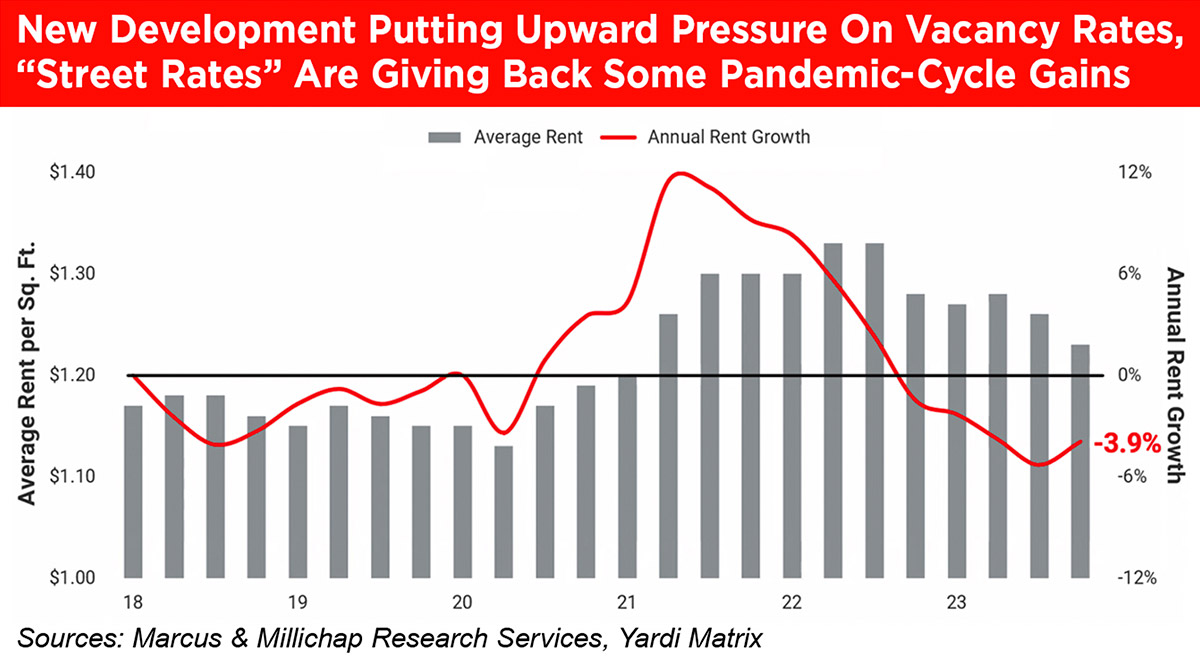
“So, trying to finance a development deal becomes exponentially harder. The only data you have is this low bar of a rental rate, versus pulling the rent roll from an existing stabilized facility to see where actual rates are in the market.”
That impacts refinances too. When investors fund deals, a financial event is often anticipated two to three years into a successful lease-up, as described in the proforma used in the capital raise. According to de Jong, “There’s a big disconnect trying to finance a development or recapitalize a property that is 30 to 50 percent leased, where rents are considerably lower than what the market actually would be once its stabilized.” Unfortunately, many proformas were based on market rates that are no longer being achieved.
Sylvester, who is also a developer, offers this advice: “The best approach to find out actual rates is not scalable, but start mystery shopping competitors to understand in-place rents. If you’re going to develop a self-storage facility and you don’t rent units in your area to see what in-place rents are, you are flying blind. No one has that data. You have to get it yourself.”
She goes on to say, “When a lender looked at a C of O acquisition in the past, when rates were 3 percent … we were looking at stabilized debt coverage ratios sometimes in excess of 2.0. So, from a lender’s perspective, they’re saying, ‘I can get my hands on this great asset alongside this sponsor, and even if they whiff on their numbers and that 2.0 ends up being a 1.6, we’re still in great shape; the loan is still performing very well.’ In today’s world, those stabilized debt coverage ratios are more like 1.35, maybe 1.4 at best, and if we take that same 40 basis point knock off on the debt coverage ratio, that loan is in a lot of trouble.”

Chang agrees. “There is more capital out there,” he says, “dry power, waiting to come back into commercial real estate. A portion of that is targeting self-storage … We’re approaching the tipping point on the psyche of investors who really do want to get that capital placed.”
Dao says, “Lenders may not understand that what they’re seeing in publicly available information is different from the specific performance of a property.” He advises that you review the data with your appraiser to be sure it portrays the market accurately. “You should be working with a professional who has real data on what the market is renting at, versus what Radius and Yardi report. Sometimes the information they skimmed off the web is very different from the property’s performance.”
As the margin for error is shrinking, your underwriting and proforma are more important than ever. A conservative approach facilitates success, as long as returns are still attractive to investors and lenders will take on the risk.
So, there are two remaining questions. For Yardi, Radius+, StorTrack: How will the industry’s data sources respond to new conditions? If they are the gold standard, they need to provide the right data to determine facility value.
And for owners of self-storage facilities: What will it take for you to be willing to share data? If you are only motivated to share in-place rent when you are a seller, then most owners won’t share data most of the time. The impact: Your facility appears to be worth less than you think because it’s appraised based on low web rates. That puts you in a tough starting place for your negotiations. Software companies in our industry say this data is easy to share, but they won’t share it unless you, the customer, asks for it. It’s done in other sectors. So, what’s holding you back?

lot of kids grow up watching their father go off to work in the morning, not to be seen again until he’d come home in the evening. And they often wouldn’t have an inkling of what he did during those eight to 10 hours during the day. For the Lindsey brothers, John and Alan, founders of Lindsey Self Storage Group, the experience was completely different.
“Our dad started developing properties in 1969,” says John. “By the time we came along in the early 1990s, he’d built properties throughout Texas and the Carolinas. And from a young age, we were working alongside him on weekends, during school breaks … whenever we were needed.”
Their days were spent on desk duty, sweeping out units, and conducting slump tests (measuring the consistency of fresh concrete before it would set). “It was every middle [school] and high school kid’s dream,” John laughs.

lot of kids grow up watching their father go off to work in the morning, not to be seen again until he’d come home in the evening. And they often wouldn’t have an inkling of what he did during those eight to 10 hours during the day. For the Lindsey brothers, John and Alan, founders of Lindsey Self Storage Group, the experience was completely different.
“Our dad started developing properties in 1969,” says John. “By the time we came along in the early 1990s, he’d built properties throughout Texas and the Carolinas. And from a young age, we were working alongside him on weekends, during school breaks … whenever we were needed.”
Their days were spent on desk duty, sweeping out units, and conducting slump tests (measuring the consistency of fresh concrete before it would set). “It was every middle [school] and high school kid’s dream,” John laughs.
“That was a big no,” laughs John. “Maybe it was because of all those years we spent on development sites, but we were both done with it.”
However, the brothers weren’t done with self-storage completely. “We didn’t want to be developers, but we also didn’t want to squander all that knowledge we’d acquired over the years working with our dad,” explains John. “But at first, we didn’t know how to apply it.”
The duo settled on starting up a self-storage brokerage firm. “It was pretty low-hanging fruit, because it doesn’t cost much to start up a brokerage,” says John. “Plus, dad knew plenty of people. He told us he’d make introductions, but outside of that, we were on our own.”
To further grow their knowledge and connections, John and Alan became heavily involved with state associations. “It was a great way to sink our teeth into the industry and meet people,” John says, adding that it wasn’t long before he and his brother had fallen in love with the process. “We started running state associations, joining boards, and working with South Carolina’s then-Governor Nikki Haley to get legislation passed. In 2015, we became founding investors in Storelocal, the industry’s largest self-storage cooperative. We just dove headfirst into everything that came our way.”
“In 2014, with international expansion on our minds, we met with FEDESSA, SSA UK, and various owners in Europe,” says Alan. “That trip re-energized us—just seeing first-hand how others approach the industry. There are similarities to the U.S., of course, but they also have a lot of unique ideas that we thought we could bring back to the states.”
He further elaborates, using Ho Chi Minh City as an example. “There, you have around 10 million people, and maybe a half dozen facilities. Now, the economy is rapidly advancing, and there’s been a huge explosion in the middle class. That means they want to buy things, but their living spaces are tiny. So, what comes next? Self-storage!”
“It’s wild to think how far the industry has come, both here and abroad,” concludes Alan. “We often wonder what our dad would say if he could see what it’s become since he struck his first deal in Dallas in the 60s.”
Alan nods, knowing what story is on the top of his brother’s mind. “So, we’re in Hong Kong, out for a drink with clients,” he begins. “One drink led to another, and another, and another … they just kept refilling our drinks. Before long, I look at John and I’m like, ‘I’m getting kind of drunk!’ and he signals, ‘me too.’ But we didn’t want to be rude and not drink what they were serving us.”
In Asian culture, Alan explains, finishing your drink is a signal that you want more. “One of our clients finally recognized what was happening and clued us in. He says, ‘If you want to quit drinking, leave some in your glass and they’ll stop refilling it.’”
Alan laughs as he relates another anecdote about cultural differences, once again in Hong Kong. “When you’re a guest in their country, your host will not end the evening until you do. We didn’t know this, and [we] didn’t want to be the ones to call it quits and possibly offend them. So, we all wind up singing karaoke in some club until 5 a.m., when, in reality, all of us probably wanted to be back at our hotels and in our beds hours ago!”
“I’d been talking to a married couple who were interested in selling their portfolio for several years, but the timing was just never right,” recalls John. “One day, the wife calls me. She informs me that her husband had died suddenly, just eight weeks after receiving a cancer diagnosis. Of course, she’s devastated. This had been her second marriage, and it was her second chance at life. And then he was gone.”
She wanted to sell the facility and make a clean break, or a “full reset,” as she called it. John went through the process of preparing the portfolio for sale, only to discover that, unbeknownst to her, the couple’s business partners in the deal had managed to tie up the property in another loan they’d taken out.
“It was a mess,” John says. “Now there’s an internal battle, four attorneys on either side, threats of lawsuits and litigation. Despite all the complexities, Alan and I got it done. We got it sold for her.”
John remains in contact with her, and they speak at least once a year. “She’s a friend now, like many of our clients,” he states.
Why was this his most memorable deal? “Because we were able to help her get out of a bad situation,” John says. “Of course, we love the $20 million to $40 million deals. But this was a deal from the heart. This was us helping someone who really needed it.”
Alan agrees. “A lot of times we’re working with mom and pops looking to retire. They’re going to make $3 million to $4 million and be set for the rest of their life. They’ve never seen that kind of money before; it’s so rewarding to work with them and watch as the world opens up for them. We love these kinds of deals.”
“There’s a lot of pent-up capital that didn’t get spent in the second half of 2023 because rates got high so quickly,” says John. “Now, people have mandates to put capital to work. Plus, with rate cuts, I think it’s the perfect storm of spending power. We’re going to see an increase in transactions.”
Right now, it’s important to look at the new construction in hot growth markets such as Atlanta, Austin, Charlotte, and Tampa. “These markets have some of the highest growth but also the most product delivery,” John explains. “So, there may be some pockets of these markets where there is overbuilding. That means you may get a four-year lease-up instead of a two-year lease-up, but it’s still a great asset because these markets are on fire.”
John acknowledges that there are some short-term supply issues in major markets causing street rates and occupancy to drop, and that operators are feeling the pressure for the first time since COVID. Still, he remains confident. “This is a short-term problem, and we see the path to the other side. Some portfolios will grow, some will shrink, but there’s good movement out there. Those that follow best practices will rise to the top.”
This is special to him and Alan because his dad had a very small team, so there are very few people who worked closely with him to talk with. “It was great to hear the grandson recall some stories about dad … to connect with the one remaining family [member] that worked so closely with him in his heyday.”
Along with the family legacy and having families of their own, the brothers also find strength and security in their extended self-storage family.
“This is a great industry to be in, and the people I know are like a second family,” says John. “When I go to an event, I know 90 percent of the people there. I see friends who started out small and are now in CEO roles. We’re all growing together and it’s amazing. It really is a blessing to do what we do.”
“Self-storage is a very unique space,” adds Alan. “In other industries, people keep everything tight to their chest. There’s no sharing of information; no one wants to be your friend. It’s the opposite here. Everyone is best friends. Many have been around for 20 or 30-plus years. We’ve been to each other’s weddings, birthdays, and so on. We work together, we play together. I don’t think you’ll find that anywhere else.”

Today, John and Alan are best friends and business partners. But growing up there was some friendly competition between the boys. “We wrestled all the time,” says Alan.
“No, we beat the crap out of each other,” John laughs. “But seriously, we had a good relationship. We had a lot of fun together.”
John attributes some of this to their age gap. “We’re four years apart, which was perfect growing up because we never overlapped in high school or got in each other’s way. We did play the same sports, we did go to the same college, and we did join the same fraternity, but there was always that four-year buffer.”
John continues, “The age gap also gave us each some special time with our father before he passed away. Being four years apart, I had one-on-one time with him when I got out of college, and then Alan had that same time when he graduated. Had we been closer in age, I think it would’ve been a different experience, more competing for his time.”
Today, John says that he and Alan are the perfect yin and yang. “I am a big picture, broad strokes kind of guy, while Alan is the ultimate details guy. I throw 10 things against the wall, and he picks the one that makes the most sense. There’s a fine balancing act between the two of us, but without Alan, the machine would not run.”
Alan returns the compliment. “I’m in the background nerding out with numbers. John is the one driving the company forward and setting the vision. Ultimately, we both play to our strengths and love what we do.”
Evolution
Of Self-
Storage
n the annals of human history, the concept of self-storage has woven a continuous thread across civilizations and epochs, starting under the pyramids of ancient Egypt to the bustling ports of the Pirates of the Caribbean era, from the vast plains of North America to the sophisticated civilizations of ancient China. It is a tale of ingenuity, necessity, and adaptation, where the need to safeguard belongings, resources, and cultural heritage has driven innovation and evolution. As we embark on a journey through time, exploring the vast history of self-storage, we uncover a story rich in diversity and complexity. From nomadic tribes to imperial soldiers, from merchants to rulers, the utilization of storage solutions has left its mark on human civilization. Yet, as we stand on the cusp of the future, the self-storage industry continues to evolve, embracing modern technologies, sustainable practices, and innovative approaches. Join us as we reach into the depths of history and uncover the past, present, and future of self-storage.
Clay pots became a common choice for storage among the populace, providing a practical and affordable solution for housing clothes, trinkets, and other essentials. However, as homes lacked the capacity to store massive quantities of goods, enterprising merchants emerged to meet this need.
These merchants offered storage services to the community, utilizing caves and ancient grain storage bins as makeshift warehouses. Archaeological discoveries have revealed the remnants of these storage facilities, displaying how large clay pots were stacked within them. There is even evidence of payment methods on ancient papyrus scripts.
This early form of self-storage allowed ordinary Egyptians to securely store their possessions, freeing up space in their homes and ensuring the preservation of their goods. While crude by modern standards, these ancient storage methods reflect the resourcefulness and practicality of ancient Egyptian society.
Moreover, in urban centers and along trade routes, ancient Chinese merchants and traders utilized warehouses to store goods awaiting transportation or sale. These warehouses, often located near marketplaces or docks, served as hubs for commerce and storage, facilitating the movement of goods across the vast expanse of the empire and along the Silk Road.
Additionally, the wealthy and noble classes in ancient China constructed elaborate estates with dedicated storage rooms or chambers. These rooms housed valuables such as artwork, textiles, and ceremonial objects, reflecting the status and wealth of their owners. Intricate locking mechanisms and hidden compartments were sometimes employed to enhance security and deter theft. Even then, technology in the storage industry was necessary.
Furthermore, travelers and pilgrims in ancient China relied on innkeepers and roadside establishments to store their belongings while journeying across the empire. These temporary storage facilities provided a haven for travelers to store their luggage and valuables, allowing them to explore or rest without the burden of carrying their possessions.
Overall, the history of self-storage in ancient China reveals a supreme understanding of organization, security, and preservation. From underground storage pits to warehouse facilities and estate chambers, ancient Chinese employed a variety of methods to safeguard their belongings, reflecting the ingenuity of their society.
These notorious settlements served as more than just dens of debauchery; they doubled as makeshift warehouses for pirate booty. Merchants operating on these islands, though wary of the lawless reputation of their clientele, found lucrative opportunities in providing storage services for the pirates’ ill-gotten gains.
Pirates would return from their plundering expeditions to offload their spoils onto these willing merchants, who gladly stored the goods securely until the rovers embarked on their next voyage. This arrangement allowed pirates to maintain a degree of flexibility, unburdened by the weight of their treasures while they prowled the seas in search of fresh prey.
However, this crude form of self-storage was not without its risks. The constant threat of raids from rival pirates or intervention by colonial authorities loomed over these pirate havens, adding an element of uncertainty to the safety of their stored goods. Nevertheless, for the daring buccaneers of the Caribbean, this arrangement proved to be a vital component of their seafaring lifestyle, enabling them to navigate the treacherous waters of piracy with a degree of logistical finesse.
Upon entrusting their goods to this type of establishment, soldiers and sailors would pay a fee for the duration of their absence, akin to a modern storage rental arrangement. This fee ensured the safekeeping of their belongings until their return.
This system of self-storage not only provided practical solutions for military personnel but also contributed to the development of early commercial enterprises catering to the needs of transient populations. It exemplifies the adaptive nature of commerce in response to the challenges of historical circumstances.
In the late 1950s and early 1960s, the first self-storage facilities began to emerge in the U.S. These early facilities, often consisting of simple garage-like units, catered to individuals and businesses needing extra space to store belongings, inventory, or equipment.
However, it was in the 1970s that the self-storage industry experienced significant growth and evolution. Entrepreneurial pioneers such as Russ Williams and Bob Munn saw the potential in providing purpose-built storage facilities equipped with various unit sizes and modern security features. They recognized the changing lifestyles and needs of Americans, particularly the increasing mobility and desire for temporary storage solutions.
The self-storage business model gained traction as more investors recognized its profitability and resilience to economic fluctuations. By the 1980s, self-storage facilities had become a common sight across the country, offering convenience and flexibility to individuals, families, and businesses alike.
The industry continued to evolve with advancements in technology, security, and facility design. Today, the self-storage sector in the United States is a multibillion-dollar industry, comprising thousands of facilities nationwide. It serves as a testament to the enterprising spirit and innovative thinking that shaped the modern self-storage business into what it is today.
Smart Storage Solutions
With the proliferation of Internet of Things (IoT) technology, self-storage facilities will become increasingly interconnected and intelligent. Smart sensors embedded in storage units will provide real-time data on temperature, humidity, and security, ensuring optimal conditions for stored items. Customers will have access to digital platforms that offer remote monitoring and management of their storage units, enhancing convenience and peace of mind.
Customizable Spaces
Future self-storage facilities will offer more flexibility and customization options to meet diverse customer needs. Modular storage units that can be adjusted in size and configuration will allow for efficient utilization of space. Customers will have the ability to customize their storage units with shelving, climate-control systems, and other amenities tailored to their specific requirements.
Eco-Friendly Practices
Sustainability will be a key focus in future self-storage facilities. Green building practices, renewable energy sources, and eco-friendly materials will be incorporated into facility design and operations to minimize environmental impact. Additionally, innovative storage solutions that promote recycling, reuse, and waste reduction will be implemented to support sustainability goals.
Virtual Storage Solutions
Advances in digital storage technologies may lead to the development of virtual storage solutions that complement physical storage facilities. Cloud-based storage platforms and digital asset management systems will provide alternative storage options for digital files, documents, and media, reducing the need for physical space while enhancing accessibility and organization.
Integrated Services
Future self-storage facilities may offer integrated services beyond traditional storage solutions. Value-added services such as on-demand pickup and delivery, packing and moving assistance, and inventory management services will be offered to streamline the storage process and enhance the customer experience.
Community Spaces
Self-storage facilities of the future may serve as multifunctional community hubs, offering shared workspaces, meeting rooms, and recreational areas. By fostering a sense of community and collaboration, these facilities will become more than just storage spaces but vibrant social hubs that enrich the lives of their users.
Overall, the future of self-storage is characterized by innovation, sustainability, and enhanced customer experience. As technology continues to advance and consumer preferences evolve, self-storage facilities will adapt to meet the changing needs of society while embracing new opportunities for growth and improvement.
However, our journey does not end here. As we gaze toward the horizon of the future, we recognize that the story of self-storage is far from over. In an ever-changing world characterized by technological advancements, shifting demographics, and environmental challenges, the self-storage industry continues to adapt and evolve.
Looking ahead, we envision a future where self-storage moves beyond traditional boundaries, embracing sustainable practices, digital technologies, and community-centric approaches—a future where storage solutions are not merely spaces to house belongings but hubs to move beyond our earthly scope.
Who knows, one day we may have storage ships that move our goods to planets far beyond our modern reach. Whatever it is, and wherever we go next, you can rest assured self-storage will move along with human ambitions just as it has for thousands of years.
elf-storage is widely considered a need-based product. While many people might associate themselves with a brand (“I’m an iPhone guy” or “I’m a Prada gal”), few outside the industry would describe themselves as a “self-storage person.” That might be changing, and StorQuest Self Storage is leading the charge.
Owned by The William Warren Group (WWG), a privately held real estate company that was founded in Santa Monica, Calif., in 1994 by William “Bill” Warren Hobin, StorQuest is 250-plus locations strong, with a team of 600-plus members spread across the country who aim to create an awesome experience for guests and partners.
Today, StorQuest appeals to adventure seekers and lovers of the outdoors with gear of all types with a website that tells visitors it is “Time to make plans, get organized, and make it happen.” So how did a self-storage brand evolve into a lifestyle brand?
“I wanted to create something different in the self-storage industry,” explains Hobin, who describes himself as an avid outdoorsman with a love for fishing, hunting, hiking, biking, surfing, and golfing. “I wanted to be unique, build a better product, and make a real connection with people and help them make their lives better.”
Naturally then, Hobin set up shop in Santa Monica, Calif., just a few steps from the beach and what he calls the “Big Blue Playground”—the Pacific Ocean.
“StorQuest Self Storage is more than just a storage company; it’s a lifestyle brand that strives to build a positive relationship with its guests to help them live a bigger life,” Hobin continues. “We encourage people to think differently about the use of self-storage.”
He says that storage shouldn’t be thought of as just something to use in a time of personal crisis, like death, divorce, eviction, or the loss of a job. “It’s okay to live in an apartment in downtown Los Angeles, or any other urban center, yet still go out and buy a kayak and keep it in a storage unit, pulling it out on weekends and hitting the ocean. The simple use of a storage unit allows someone the ability to pursue their passion, enjoy life, and live big in the now.”
Hobin knows that work can be hard and stressful, so he says it’s important to make time for play too, encouraging his employees to take advantage of the surroundings. “It’s okay [for employees] to take meetings on a walk along the bluffs of Santa Monica … Go for a run at lunch, jump in the ocean, take out a surfboard, or bike along the beach path. I don’t care if you take longer than a standard one hour. As long as you are getting exercise and enjoying our immediate surroundings, go do it and live big yourself.”

She also cites studies from that show that cluttered environments can make people less satisfied with their lives, pointing to neuroscience research from the National Center for Biotechnology Information (NCBI) that found clearing clutter from a home or work environment resulted in a better ability to focus as well as increased activity and productivity.
“That brand strategy carries over into why we aspire to be the most creative, entrepreneurial, profitable self-storage company and operator in the industry for our owners, investors, and developers,” says Gary Sugarman, COO. The company is accomplishing this by expanding its team, entering new markets, and investing a significant amount of capital into its operating platform. In addition to partnering with institutional capital partners, the company sees a lot of continued potential for growth in the third-party management platform. “It’s important that, as much as owners like our brand, we have to like the asset, the market, and the people to ensure that we’re maintaining brand consistency and brand integrity for our guests,” says Sugarman.
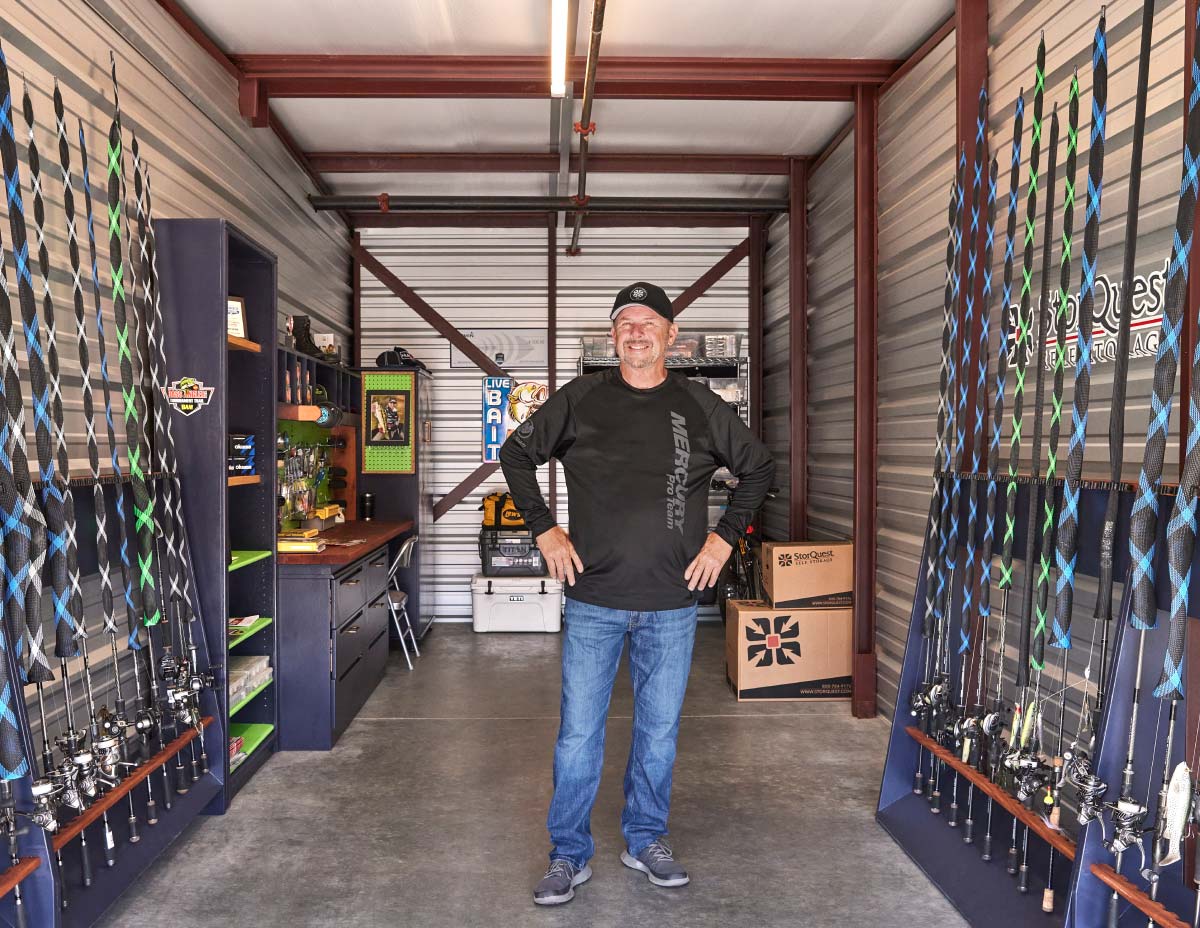
StorQuest creates energy efficiencies in its daily operations, including maintaining carbon neutrality for its managed portfolio through such efforts as high-efficiency lighting, solar installations, and carbon offsetting.
The company is also committed to giving back; it has partnered with a range of nonprofits and donates $1 for every new rental at each StorQuest location to one of them.
Through its StorQuest for a Cause program, WWG has donated to community partners like One Tree Planted, Friends of the LA River, and Hawaiian Legacy Reforestation. (Learn more about sustainability at WWG or to read their inaugural Impact Report at www.williamwarren.com/sustainability).
As a company, William Warren Group and StorQuest Self Storage are focused on innovating and building for the long term, says Stevie Roberts, ESG manager at William Warren Group/StorQuest. “It’s one thing to talk about living an adventurous life; it’s another to support causes that help make that possible by protecting our planet. Here at WWG and StorQuest, they go hand in hand as the foundation for our growth and success,” says Roberts.


“My StorQuest unit is great; I actually come in here and smile. It feels safe. In fact, I feel it’s safer here than in my own house. This is the most organized anything in my life is.”—Kelly Slater
“To me, this isn’t a collection of stuff; it’s a collection of experiences. Each piece tells a story—places I’ve been, things I’ve done. It’s good to look around and know that everything is so organized and secure.”–Tony Hawk
To accomplish this, the company commissioned muralist Ruben Rojas to design the mural on the side of its Oakland, Calif., facility, facing interstate 980 for maximum visibility. “StorQuest wanted to use art and a powerful message … a love letter from Earth to us,” says Rojas. His art depicts the planet with a note that reads “Love me before I’m gone.”

In addition to making a statement through art, StorQuest asked community members to spread the word about healing the planet by using the hashtag #RootForTheFuture in social media posts.
“When I learned about the BAM tour, and how our sponsorship could help them, I thought the events aligned perfectly with the StorQuest brand ideology, which is to get out there, discover, and live a bigger life,” he says.
Aside from that natural synergy, outdoors individuals have lots of gear, vehicles, and/or boats. “For them, their friends, family, and fans to consider using storage units as an extension of their garage, opens up a huge marketing opportunity for us,” Hobin explains. “This is a chance for us to educate the community on how storage utilization can help simplify and improve their lives. That’s our job.”
Wiegand agrees. “This sponsorship is bringing together the worlds of outdoor sports and practical storage solutions. By getting involved with the BAM Tournament Trail, we’re showing our commitment to supporting the lifestyles and passions of our guests.”

By Erica Shatzer
Nearly 30 years ago, William “Bill” Warren Hobin was working for a large, regional home builder when he took notice of the lack of closets and storage space in newly constructed homes. Concurrently, he was dating the daughter of the owners of a self-storage facility in Ventura Country, Calif. Hobin, who was curious about the storage business, had plenty of questions for his then-girlfriend’s parents. Although that courtship fizzled, he went on to consult for his ex’s folks when their self-storage investment’s profits had fallen flat.
In an effort to help the couple ramp up revenue, Hobin searched for suitable professional management to oversee the day-to-day operations of the self-storage facility. While his efforts to find an existing satisfactory management company failed, Hobin didn’t throw in the towel. Instead, he rose to the occasion and formed his own self-storage management company to take over the daily operation of that one facility. “I figured if I learned how to operate it, I would have a good chance of raising capital and building my own store someday,” recalls Hobin.
And the rest, they say, is history.
Read the full story in the MSM Archives. Type “Bill Hobin” in the search bar to find this issue and others in which he’s been featured.
ith construction costs, interest rates, and land prices higher than we’ve seen in years, many developers are looking for ways to save on building costs. Projects were put on hold while the industry waited to see what would happen with construction and with interest rates. Now, many of these projects are moving forward as seasoned self-storage developers adapt to numbers that may be the new normal, while newcomers may find themselves priced out of entering the market.
David Dodge, president of Little Rock, Ark.-based Paramount Metal Systems, says costs have increased considerably since COVID. “They’ve somewhat stabilized lately, but at a price higher than what everybody’s been accustomed to,” Dodge says. “Electrical, steel, insulation, mechanical, labor—almost every sector has seen increases.”
Not only has the cost of materials leveled off, Bergmann says, but supply chain issues have eased as well. However, prices are still elevated from four years ago. “It’s all supply material driven, so we’ve seen some stability in the metal markets and better availability getting mechanical units and electrical gear,” he says. “We had problems for a while getting those and getting roofing materials, but we can get them now.”
However, labor is a persistent factor of higher construction costs. “The construction industry as a whole has been suffering on labor for 20-plus years, and it’s becoming a real problem,” Bergmann says. “It’s become a challenge for contractors and a big issue for the subcontractors.” He notes that like everyone else, laborers are facing higher costs for goods and services, and they need pay raises. “They have to be able to put gas in their cars and buy groceries and pay rent,” Bergmann says.
Starr Cannon, vice president of Lawton, Okla.-based Cannon Storage Systems, says her company hasn’t seen materials costs leveling out yet. “We had price increases in January, February, and March,” she says, adding that metal, doors, and all of their main components have seen increases in addition to an increase in labor costs.
Cannon says stricter building codes are also adding to development costs. “In Oklahoma, every 2,500 square feet now requires a firewall,” she says. “If you build a climate-controlled building, you have to have a bathroom within 500 feet.”
In addition, municipalities are demanding more expensive aesthetics in public-facing sections of new self-storage facilities. Expensive exterior finishes, more glass, and upgraded landscaping are adding substantial costs to building in many urban and suburban areas.
Staying aware of new requirements and rising construction costs can prevent surprises. “Developers only remember the last project,” Dodge says. “It was X amount per square foot, so they used that as their budget for the next one. So, now they’re spending more money than they want to, and the higher costs may have to come out of pocket.”
Cannon says construction inflation and higher financing costs haven’t significantly affected the larger operators they work with; however, high costs are keeping others from upgrading or developing. “We’re not getting as many calls from mom and pops or brand new investors,” Cannon says. “They used to make their money back in three years, but now it’s going to take five to seven years. It’s hard to just put up a building with costs around $24 per square foot. So, the people we are building for now have been in the industry a while.”
Although financing costs may be the biggest issue, there are ways developers can cut building costs. “Developers are looking at maybe doing different site or building pad preparation, or changing the sub-grade on the site,” Bergmann says. “It’s going to have a pretty big impact. We’ve looked at different building pad assemblies for some of our customers. We can work with the geotechnical engineer and the civil engineer, and together, we can look at the site as a whole and try to find ways we can do something a little bit differently to save the customer money.”
Dodge agrees that this is an area for potential savings. “One project we’re doing now, our engineers took a look at it and we felt like the foundations were way over-engineered,” he says. “We sent it to our consulting engineer, and he was able to save them $100,000.”
Roofing choice is also a cost factor. “They can use metal roofing in lieu of membrane roofing,” Bergmann says. “In fact, we recently had a project that had membrane roofing. We were able to change to metal roofing and save the customer 25 percent on the roof. That’s substantial.”
Developers can also save on exterior aesthetics if municipalities will allow it. “Some require so much brick and so much glass, which drives the costs up,” Dodge says.
Even in aesthetically demanding municipalities, compromise might be found. “Depending on the jurisdiction, they may choose to go with an all-metal clad exterior rather than masonry or stucco,” Bergmann says. “With metal cladding, the architects have done a really good job of mixing some of the metal profiles and colors where they can look really awesome. They’re mixing vertical and horizontal and it’s trendy.” Savings may also be found by looking into alternative lighting materials.
A principal area in which a developer can drive down costs is strategic site selection. “They may be able to buy a site that already has utilities at the front of the roadway,” Bergmann says. “Or they may be able to buy a site that’s a little bit smaller overall, so they don’t have to develop more than they need.”
Bergmann has seen some deals pencil out because they chose a very good site from a construction standpoint. “There are definitely sites that are easier to build on than others,” he says. “For a developer, site selection is everything.”
While the cost per square foot will increase, scaling back may be necessary if there is a demand issue. “Money is very expensive, and the banks are cautious,” Bergmann says. “They are scrutinizing every deal making sure that there is plenty of demand for what they’re trying to build.”
Cannon has seen another trend related to rising construction costs: developers who would rather pay today’s prices than risk unknown building costs in the months to come. “We are noticing that people are building in one phase instead of two or more,” Cannon says. “They are taking the hit all up front because they may get a better cost and they want to avoid the risk of the costs increasing for a second or third phase.” Although the developer is paying interest earlier, they know what the costs will be, she says, adding that those costs could go up 5 percent in a year.
Scaling back on how much climate-controlled space is built is another potential cost cutter. “Ask whether it’s necessary,” Cannon says. “You can look at putting up a non-climate-control building with extra insulation to make it cooler and more airtight.”
Dodge says that when a developer hires architects and engineers, they usually focus on optimal design rather than figuring out the minimum required for the building to function. “They will take the path of least resistance rather than looking for minimum essential design,” he says.
To that point, Cannon says some layouts can leave money on the table. She recommends going back to a simpler design and getting rid of wasted space. “Redesigning a site can yield them more storage,” she says. “If you have a 10-by-20 and you have to get $200 for it, you can instead do four 5-by-10s for $2 per square foot. People don’t blink at that, while getting $200 for the single unit may be more difficult.”
Higher costs affect self-storage development in many ways. Meeting the budget may require scaling projects back in size, redesigning for maximum storage space, or changing materials. Some materials’ costs leveled off in the first quarter of 2024; however, there is no guarantee they won’t rise again. Even if these prices stall, self-storage builders say it’s unlikely they will come back down. Despite this, they agree that these higher costs won’t have a significant effect on development because demand is still very high.
“I’ve been doing this for 40 years, and in the first 30 years, we saw cycles,” Dodge says. “About every five years it would slow down for two or three years until housing caught up. But in the last seven to 10 years, the word got out. Now everyone who has a few expendable acres wants to build mini-storage.” Although higher costs may be an impediment to some, self-storage development remains robust.

hen venturing into the construction of a multilevel self-storage facility, several designs and structural systems come into play, each with its own set of advantages and complexities. Let’s explore some of these systems and uncover their significance in today’s modern era.
Now, about lateral resistance: It’s especially important in areas prone to earthquakes, like the West Coast. Depending on factors like the number of stories, soil conditions, and exposure, extra measures may be needed. The U-panel sheathing can sometimes provide enough lateral resistance, but in cases where more is needed, flat-sheet steel or additional structural elements like masonry shear walls or steel brace frames may be added. However, designers usually avoid the flat-sheet approach due to issues with fastener spacing and aesthetics. These additional elements can affect things like corridor layout, door placement, and even future flexibility if unit sizes need to change.
Other lateral resistance strategies include masonry shear walls or engineered structural steel (“red iron”) brace frames. It’s worth mentioning that masonry shear walls and shafts have fire-resistant properties, which can be beneficial for meeting building codes. However, incorporating these elements can complicate construction timelines due to additional subcontractor coordination and fabrication processes. We advocate for early coordination with the structural design consultant when using brace frames or full-height masonry shear walls to vet out impacts to building design and unit layout. It should be noted that these types of lateral resistance elements can have an adverse impact on future flexibility if an operator were to want to reconfigure unit sizes in response to market conditions.
While the light gauge bearing wall system offers simplicity and efficiency, it’s essential to consider factors like lateral resistance and construction sequencing when planning multilevel storage facilities.
Post and beam systems offer a different approach compared to the light gauge bearing wall system, providing increased flexibility for future layout changes in storage units. Unlike the continuous bearing walls of the light gauge system, post and beam setups allow for more adaptable configurations. During construction, this setup also facilitates easier removal of snow, water, and debris until the perimeter walls and interior corridors are established.
An emerging variant of the post and beam system is the Alpha Framing system (see the photos for examples). This system employs factory-assembled, built-up light gauge columns arranged on a 10-foot grid to support concrete-filled steel beams. These beams, in turn, uphold concrete slab on composite metal deck floors, akin to traditional light gauge bearing wall designs. The Alpha Framing system marries the efficiency of light gauge framing with the flexibility and openness of post and beam layouts, bypassing the need for extensive structural steel components and associated fabrication processes.



It’s crucial to note that post and beam systems may still require supplementary lateral resistance components, akin to the considerations in the light gauge bearing wall approach. Collaboration with your design team and structural engineer is paramount to address seismic and lateral resistance requirements, along with the accompanying programmatic, coordination, and engineering considerations previously outlined.
Furthermore, when incorporating lateral resistance elements into projects, careful consideration should be given to their visibility within the facility. Will these systems be exposed or concealed within walls or behind finished panels and claddings? This decision impacts not only the aesthetics but also the overall functionality and user experience within the storage facility.
However, while the building code offers new possibilities, it’s crucial to align these considerations with local zoning and planning regulations. Factors such as building height restrictions, floor area ratios, and other local ordinances can impact project feasibility. Collaboration with your design team is essential to navigate these complexities effectively, ensuring compliance while maximizing project potential.
Engaging an architect or design team with expertise in self-storage facilities can provide invaluable guidance throughout the planning, design, and construction phases. Their experience enables them to offer insights tailored to the unique challenges of multistory storage projects. Additionally, partnering with general contractors and subcontractors familiar with self-storage construction further enhances project success, ensuring seamless execution from concept to completion. By leveraging the expertise of these professionals, you can optimize your project’s outcomes and deliver a successful multistory self-storage facility.
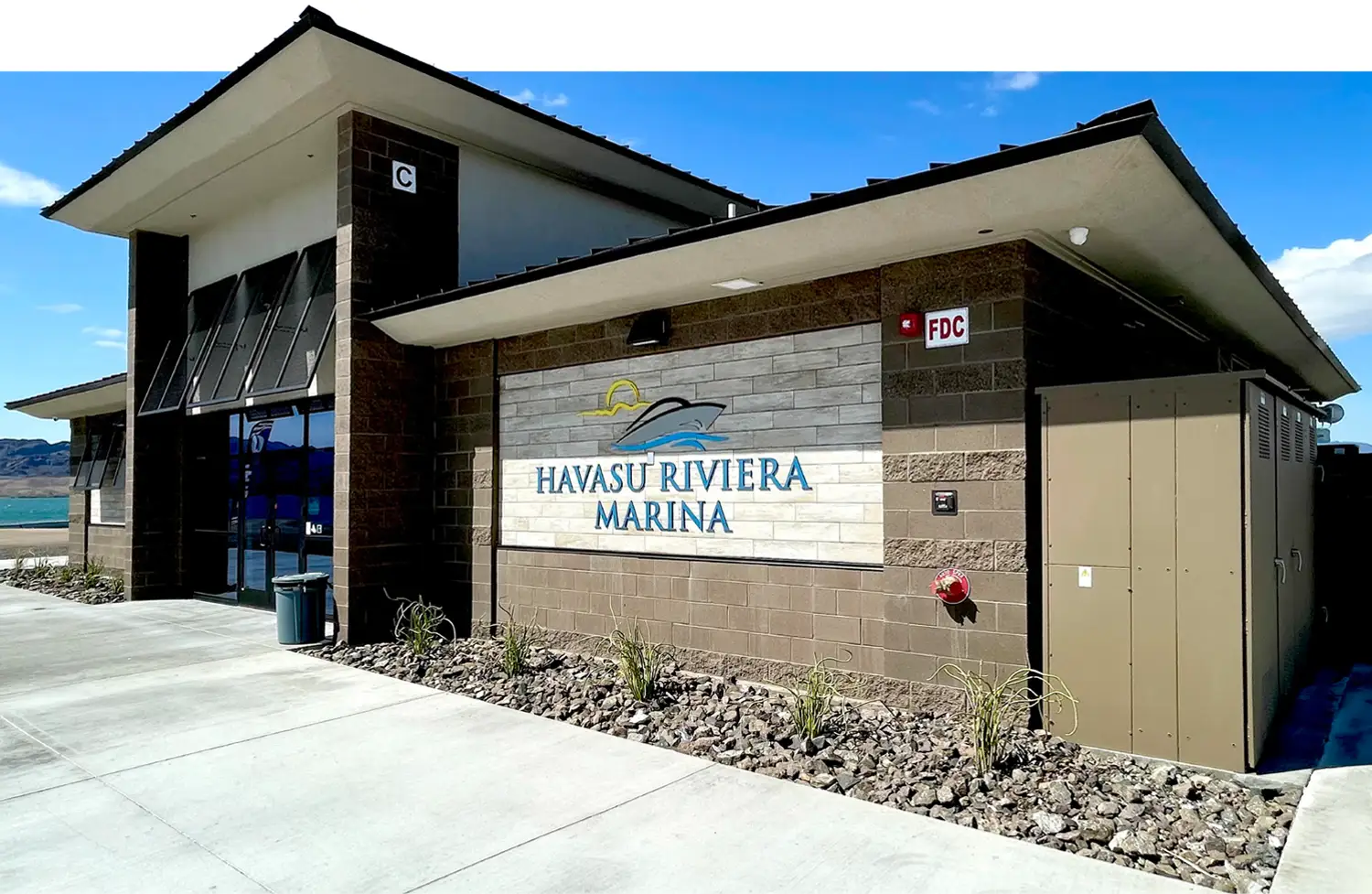
n April 1, 2024, Havasu Riviera Marina, an innovative on-the-water boat storage facility in Lake Havasu, Ariz., that’s being developed in phases by Forge Building and Desert Land Group, began renting its newly built, covered boat slips to customers. Available in three sizes to cater to varying needs, the 60 slips were designed across two structures and provide overhead protection through a steel cover that serves as a canopy. Erected in less than two months, the steel structures are supported by a reinforced floating dock system that took 16 months and insight from steel engineers to construct.
For customer convenience, Havasu Riviera Marina offers a fuel dock with three types of gasoline, boat rentals, a six-lane boat ramp, and a marina store that sells food, beverages, ice, apparel, boat and marine accessories, and safety equipment. Provisions have been made for the installation of lifts to enable renters to effortlessly hoist their vessel out of the water. Other planned amenities to be delivered in upcoming phases include a 60,000-square-foot pre-engineered metal building with racking systems for dry storage, various concierge services, a restaurant and bar, and a 100,000-square-foot self-storage building.
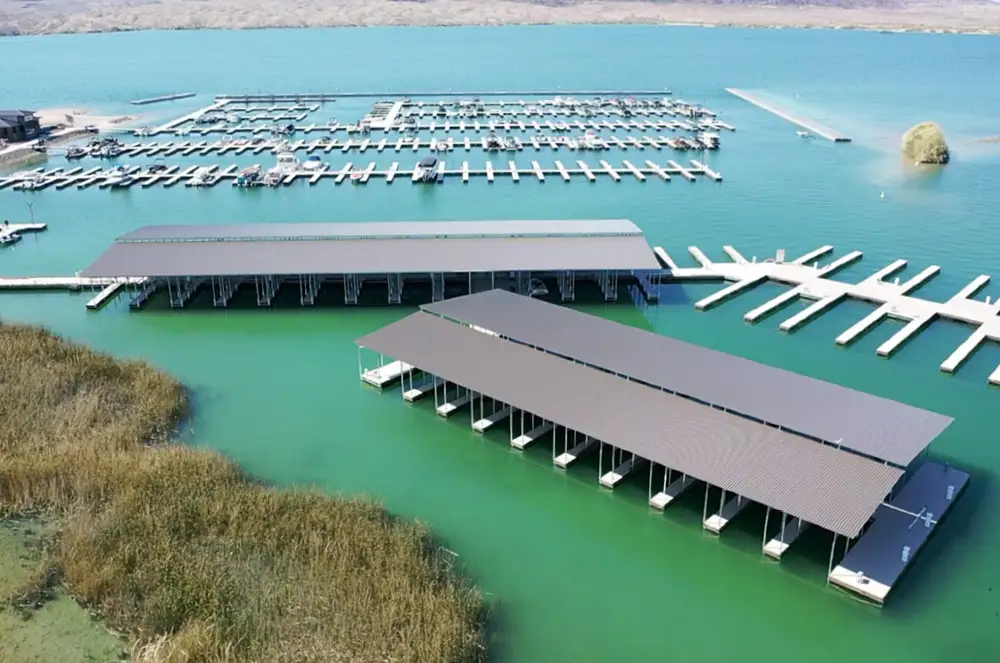

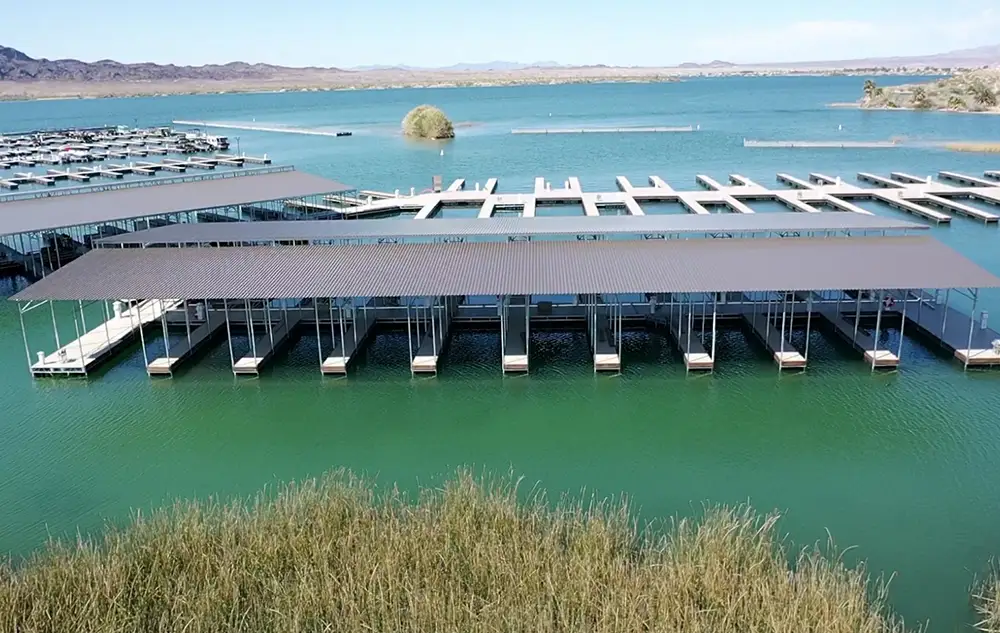


he self-storage industry may have been slow to implement technology—some facilities didn’t even have websites until the past few years—but since COVID, technology has swept through the industry at lightning-fast speed.
Facilities today should have at least a great website and a facility management system that integrates your operations, including allowing prospective tenants to reserve a unit, rent, and pay online.
“Time is a major cost to not having a good management system,” says Will DeBord, director of product, Nokē by Janus International in Temple, Ga. “A good management system helps organize your business and automate tasks, which leads to more efficiency for your operations team.”
If you’re not using modern facility management software, it could be costing you business and could ultimately lead to devaluing your property. “Storable has many customers who actively shop for underperforming facilities,” says David McCormack, Raleigh, N.C.-based director of solutions architecture at Storable. “These growth-oriented customers will buy struggling self-storage businesses at a steep discount; implement modern tools, such as access control, website, lead generation, and other tools; and quickly turn a profit by replacing the dated management products, process, and technology.”
Operating System Vs. Management Software
Storable’s website describes facility management software as being “primarily designed to streamline operations of your facility and make it easier to operate a successful business. At its most basic, management software keeps track of unit availability, prices, and tenant records. However, management software for self-storage has grown more sophisticated with time. Today’s storage management software can do everything from controlling your access control systems to sending payment reminders to delinquent tenants.”
McCormack adds, “Facility management software [FMS] is the nucleus of a self-storage facility’s business. Integrated into FMS are all the products and services your tenants interact with, such as the website, kiosks, payment system, access control, and communications. When an FMS product fails, the entire ecosystem is in jeopardy. My advice is to carefully choose the FMS which can deliver superior uptime, support, and accommodate your future growth.”
To make an informed decision, here are questions to ask before choosing a facility management system:
- Is it cloud based? This is an important question in today’s world, especially when there seems to be so many natural disasters. “It is vitally important to have all of your systems based in the cloud,” says DeBord. “Otherwise, you are vulnerable to on premise equipment going offline or having power failures.”
- What kind of self-storage business do you have? McCormack adds to note whether it will be automated, unstaffed, traditional, or another business model.
- Will your business include any nontraditional storage products or services McCormack says this question enables facility management software providers to determine the best product for your entire business.
- How large is your business? Scalability can impact your choice. Therefore, McCormack says it’s important to tally how many facilities are in the owner’s portfolio as well the average number of units per facility.
- Will you own your data? “Data is the new currency of business,” says Justin Paquin, senior director of product at Tenant Inc. “Leading businesses leverage their data to maximize customer experience, optimize operations, and drive business decisions.”
- Are APIs available? According to the Storgaznize blog, open API refers “to a public programming interface that allows different software systems, such as access control systems, accounting software, and CRM systems to integrate and communicate seamlessly.” DeBord says, “If your management software does not integrate well or properly with your website, access control, or other systems, your operation could suffer.” Paquin suggests asking these two questions: “Are the APIs complete or do they only offer partial coverage? Do you or other vendors have to pay to use them?”
- Will you be able to get support when you need it? “Your FMS is hub of the software portfolio for your storage business,” says Paquin. “Unresolved challenges, questions, or issues can impact your tenant experience and cost you money.”
- Does the vendor have a track record of innovating and solving problems differently and better? “Just like a great hire, selecting the right FMS will sell more, make better decisions faster, and run your business more efficiently,” Paquin says.
“Facility management software [FMS] is the nucleus of a self-storage facility’s business. Integrated into FMS are all the products and services your tenants interact with, such as the website, kiosks, payment system, access control, and communications. When an FMS product fails, the entire ecosystem is in jeopardy.”
Other features that are nice to have include auction service integration, web hosting options, and call center integrations, says DeBord. And if you want a jump on waves of the future, “more cutting-edge features that are not mandatory today include revenue management integrations, AI capabilities, and identification verification,” he says.
Pros And Cons Of FMS
Beware of mixing different systems, or make sure they can communicate with each other if you do, says McCormack. “One of the major pain points we see many of our customers coming to us to resolve is the result of mixing and matching many different providers for services. Having a choice of service providers is important. However, when things are not functioning properly, having many integrated vendors, who usually don’t communicate with each other, often causes delay in problem resolution, and sometimes lack of vendor accountability. The solution to this problem is having as few competent providers as possible and ensuring that the providers you have decided upon have the depth of experience and the resource commitment to solve your business problems, end to end, in a timely manner.”
There is no one solution fits all, which is why there are several reputable FMS companies that serve the self-storage industry. The key, says DeBord, is to find the best solution for your business. “When evaluating any software solution, it is important to understand your current processes and consider how the product fits into your processes, or how to improve your processes. If you do not understand how to improve your process or think the solution makes your process more difficult, it is good to inquire about best practices that the companies currently use. Understanding customer support hours, account management practices, and onboarding processes of the provider is another important area to understand.”
Investment
Options
Four Methods For Investing In Self-Storage
he self-storage industry offers an exceptional opportunity for investors looking for stable and recession-resistant income streams in the current investment landscape. With more than 52,000 self-storage facilities generating over $39 billion annually in the U.S. alone, the market’s breadth and resilience are apparent. There are several methods an investor might consider when looking to enter this lucrative industry. Each method has its nuances, benefits, and considerations that align with different investor profiles, objectives, and risk tolerances.

Buying your own place involves purchasing an existing self-storage facility or developing a new one. This method is best suited for investors who seek hands-on management and operational control. It offers the potential for high returns through value-add strategies such as facility improvements, operational efficiencies, and marketing enhancements. However, it requires significant capital upfront and involves ongoing operational responsibilities, making it a better fit for those with industry experience or the willingness to put time into mastering the operational aspects of self-storage.
This approach is typically capitalized by a mix of cash invested by the owner and debt funding from a financial institution. Acquiring a facility in this manner does not require that the investor be accredited.

Investing in self-storage REITs is a way to gain exposure to the industry without the complexities of direct management. REITs pool money from many investors to purchase and manage real estate portfolios, offering investors liquidity and the benefit of receiving dividends. This method particularly appeals to those seeking passive investment opportunities with less risk and lower capital requirements. While it provides less control over individual investments, it offers diversification and professional management.
These are the six largest and most well-known REITs currently:
- Extra Space Storage (EXR): The largest in the U.S., this REIT is praised for its sustainability and long-term goals, providing various storage solutions, including climate-controlled units. Last year, EXR acquired Life Storage, Inc. (LSI), another REIT that was known for its comprehensive self-storage solutions, to become larger than Public Storage.
- Public Storage (PSA): As the second-largest self-storage REIT, Public Storage has a robust portfolio and is recognized for its sustainability efforts. It’s listed on the NYSE and is part of the S&P 500 and FT Global 500.
- CubeSmart (CUBE): Ranking the third largest in the U.S., CubeSmart focuses on offering affordable and efficient storage solutions. It is known for consistent dividends and a stable growth model.
- Global Self Storage, Inc. (SELF): This self-managed REIT specializes in high-end storage solutions, like wine storage and climate-controlled units, serving a niche market with a high dividend yield.
- SmartStop Self Storage REIT (STSFF): SmartStop is a self-managed REIT offering a wide range of storage solutions. It is known for its premium features and high dividend yield.
- National Storage Affiliates (NSA): It aims to cover both high-quality and more affordable sections of the storage market, emphasizing transparency and corporate responsibility.
An investor does not need to be accredited to invest in a publicly traded real estate investment trust (REIT). Anyone who opens a brokerage account can buy shares in a REIT listed on major stock exchanges, just like any other public stock. The investor can also purchase shares in a REIT mutual fund or exchange-traded fund (ETF).

Private equity funds specializing in self-storage allow investors to contribute capital to a fund that will then be used to acquire and manage a portfolio of self-storage assets. This method offers access to high-quality investments that might be otherwise inaccessible to individual investors. It requires a higher minimum investment compared to REITs but offers the potential for higher returns, given the focused expertise of fund managers in identifying value-add opportunities within the self-storage sector.
Private equity funds are typically available only to accredited investors. The investor should refer to current SEC regulations to assess their qualification. The fund manager usually requires paperwork to prove that the candidate investor meets SEC requirements.

Syndication involves pooling funds from multiple investors to purchase or recapitalize a self-storage facility. This method lowers the individual capital requirement, making it available to a broader range of investors. Syndications are typically managed by experienced operators who handle all aspects of the investment, from acquisition to operation and eventual sale. This method offers investors a balance between the hands-off nature of REITs and the direct involvement of owning a facility, with the added benefit of potentially higher returns due to the targeted nature of the investments.
Websites like StorageTrader, FundRise, CrowdStreet, and RealtyMogul make it easier and more accessible for investors to enter the syndication space with lower initial investments. Investors are advised to perform due diligence on both the platform and the deal being offered. These investment platforms usually require the investor to certify their identity and accreditation status. They offer the advantage of providing deals for investors’ consideration, as simply as shopping on Amazon, thereby saving considerable time on the investor’s part in locating investable opportunities.
The choice among these investment methods depends on several factors, including the investor’s capital availability, risk tolerance, desired level of involvement, and investment horizon. Direct ownership and syndications offer more control and potentially higher returns but require greater capital and active management. In contrast, REITs, private equity funds, and crowdfunding present more passive investment opportunities with varying degrees of liquidity, capital requirements, and exposure to risk.
Investors leaning toward hands-on management might prefer direct ownership or syndications, relishing the operational control and the challenge of enhancing asset value. Investors who join syndications are encouraged to review the operating agreement to fully understand their level of control. Those favoring a hands-off approach might find REITs or private equity funds more appealing, benefiting from professional management and diversification without the day-to-day operational concerns.
In conclusion, the self-storage sector offers a robust investment landscape with multiple entry points for investors. Whether through direct ownership, REITs, private equity funds, syndications, or crowdfunding, each method presents distinct advantages and considerations. By carefully assessing their investment goals, capital availability, and risk tolerance, investors can select the method that best aligns with their strategic objectives, paving the way for a successful venture into the growing and resilient world of self-storage investing.

elf-storage owners are faced with uncertainty every day, and a lot of that stems from nagging questions over pricing. Whether an operator follows a cost-based, competition-based, or value-based pricing strategy—or an advanced AI-driven revenue management solution—there are always going to be certain biases at play that can impact their decision-making.
We all know how bias works from a social aspect, in which some people may discriminate between those who are like them and those who are not like them. In a business context, however, bias becomes a natural inclination for or against an idea. It is often shaped by a person’s own background, outside influence, aversion to risk, and knowledge of financial concepts.
“We are all rife with biases,” writes Blair Enns, author of Pricing Creativity: A Guide To Profit Beyond The Billable Hour. “They originate in the gap between our two systems of thinking—our quick, intuitive, shortcut-based system that lets us do complex things like simultaneously drive a car while talking on the phone and drinking hot coffee without much conscious attention or cognitive cost, and our more considered, analytical system that lets us do long division.”
Within this gap lies six different types of biases that cause some operators to fall into certain traps when it comes to pricing. Dr. Ahmet Kuyumcu, founder and CEO of Prorize, recently explained to this writer the most common pricing mistakes self-storage operators make because of their own biases. Leaning into any one of them, he says, can result in an operator waving a white flag in the current pricing wars.
Humans tend to believe that over time outcomes will “self-correct” back to an average result. This leads to the gambler’s fallacy: the mistaken belief that if an event occurred more frequently than expected in the past, then it is less likely to occur in the future (and vice versa). You see it all the time in casinos. Picture people around a roulette table where red has come up five times in a row. The gambler’s fallacy can cause someone to mistakenly assume that black is overdue, so they slide their chips over to black. What happens? It lands on red again. Now, while it was true that red had come up more frequently than expected, the fallacy was that black must be next. However, we know that the outcome of the next spin in roulette is independent of the outcome of the previous spin.
Self-storage owners evaluating demand for a self-storage facility may also fall prey to the gambler’s fallacy. Faced with a series of high-demand periods, this bias might lead them to wrongly anticipate a decrease in demand for the next period, reasoning that such heightened demand is unsustainable (“This trend can’t last forever,” they may say to themselves). So, they lower prices in anticipation of demand slowing. However, it may be that this trend could continue for some time, and the owner is now renting out units for less than they are worth.
Anchoring occurs when individuals use an initial piece of information to make subsequent judgments. Once an anchor is set, other judgments are made by adjusting away from the anchor, and there is a bias toward interpreting other information around the anchor.
Let’s put this into a self-storage scenario in the context of pricing. Some operators will show the most affordable unit by itself to drive traffic to their website. It sounds like a solid strategy in theory. However, this doesn’t provide the consumer with a frame of reference to help them establish value for the unit. If they simply see a 10-by-10 for $55, they have no idea if this is a reasonable price—i.e., they have no anchor.
In his story on value pricing, Kuyumcu explains that one way to establish value is to show a discount with “$110 $55,” where $110 is the anchor price for the $55 value price. A more effective way is to show Unit A and Unit B next to each other. This display would make Unit B look like a bargain since the price of Unit A is disproportionally higher.
See table

How many times have you thought, “It worked before, so I’ll try it again.” It’s human nature. Even President Franklin D. Roosevelt followed this rule, stating, “Do something. If it works, do more of it. If it doesn’t, do something else.”
Unfortunately, basing future actions on an action that worked once or even a few times before is relying on a very small data set. Statistically speaking, you’d have to do something many times to get to the point where you could say, with confidence, that it will work again next time.
That doesn’t stop some self-storage owners from relying on small data, however. If they had one or two customers complaining about rent increases who moved out as a result, they assume that all move-outs they see are happening because of rent increases. But was the rent increase the catalyst for higher move-outs? Perhaps the move-outs were natural. Maybe it was a seasonal thing. There are a variety of reasons that move-outs could have occurred that had nothing to do with the rent increase. However, the operator doesn’t take this into consideration and avoids raising rents to the detriment of the bottom line.
The confirmation bias occurs when we use, or seek out, data or information that confirms what we already believe. It’s the reason why most people who lean left watch CNN, and those who lean right watch FOX News; these outlets are likely to confirm what they believe politically. While some confirmation bias is often unintentional, it can still lead to poor decision-making because we accept it as true and overlook any flaws or inconsistencies.
On the other hand, if the new information contradicts what we believe, we respond differently. We are more likely to become defensive about it and focus on criticizing flaws that would otherwise be ignored if the information confirmed our beliefs.
In self-storage, Kuyumcu observes a common tendency among operators: They often start with a predetermined conclusion and then seek evidence to support it. For instance, they might believe that offering a one-month incentive is crucial to attract new tenants, especially if they notice competitors doing the same.
However, the reality is more nuanced. Customer churn over three months can range significantly, from 15 percent to 60 percent, depending on various factors, including store location, unit size and type, seasonality, and the demographic served (such as commercial, military, or student clientele). Despite this variability, operators often overlook these complexities due to their confirmation bias, steadfastly clinging to the notion that offering a one-month incentive is the only solution, all the time. If someone were to point out that length-of-stay may vary and that the incentive would cause them to lose revenue in some cases, which goes against the owner’s belief, he or she may wave it away, saying “Move-in offers are needed to increase revenue,” when in fact, upfront move-in offers might not always be a revenue-maximizing solution.
The availability heuristic, also known as availability bias, is a mental shortcut people use when evaluating a situation. This operates on the notion that if something can be recalled, it must be important, or at least more important than other possible scenarios. In other words, the easier it is to recall the consequences of something, the greater those consequences are often perceived to be.
How does this work in the self-storage realm? A good example is overestimating the impact of rent increases and jumping to the conclusion that increases result in move-outs. Another example is calling around and finding out that a competitor is offering 50 percent 10-by-10s for four months, assuming that they do the same for all other unit types, and then overreacting by doing the same.
There’s a portion of our brain called the amygdala that screens everything we do for potentially negative outcomes. According to scientists, this means that we pay 10 times more attention to bad thoughts than to positive ones. Many psychologists also believe that we’re simply hardwired this way, that pessimism is an innate survival mechanism passed down to us by our ancestors who always had to be on the lookout for predators and prepared for the worst since their chances of being killed by animals or other human beings were once very high.
The pessimism bias, then, is the human tendency to assume the worst, regardless of the actual probability of negative outcomes. It can affect decision-making processes and cause stress, anxiety, and a lack of motivation. When it comes to self-storage pricing, an operator may fear that by raising rates occupancy will plummet. This inevitably results in prices remaining flat, even as the cost of doing business increases.
“When you look at pessimistic people, probably the single [most telling] hallmark is they think that bad events are permanent and that they’re unchangeable,” says Dr. Martin Seligman, author and psychologist. “So, what learned optimism is all about is recognizing that you’re saying that to yourself, and then realistically arguing against it.”
Of course, being overly optimistic comes with pitfalls of its own. But in general, being too pessimistic can really hurt a business’ profitability. “You cannot run your business by assuming the worst-case scenario all the time,” explains Kuyumcu. “In any business, you have to be willing to take some risks and deal with uncertainty.”
Of course, as with any new technology, some operators have fears about AI—fears they need to overcome, says Joseph Steinberg, AI and cybersecurity author, advisor, and speaker.
“This technology is here to stay, and there is no turning back,” he said in an exclusive 2023 MSM interview on artificial intelligence. “AI benefits both owners and tenants. If used correctly, owners work more efficiently with less effort and tenants easily get what they need without a lot of hassle.”
That is exactly what Prorize and other AI-enabled technologies do for the industry—help owners set the prices smartly, which in turn allows consumers to get appropriately priced units.
“An AI system is data-driven and eliminates guesswork and common human biases,” says Kuyumcu. “Prorize analyzes hundreds of combinations of parameters to predict the prices customers are willing to pay for various types and sizes of storage units, which may need to be adjusted daily or even in real time.”
He adds that while Prorize’s AI provides guidance, the system can be overridden, especially when the relevant information is missing. For example, if demand is low because roads are blocked due to major construction, the system wouldn’t know this and would react to the slower demand. Operators can help the system by overriding the recommendations in these cases.
Kuyumcu says that some customers always follow the AI’s recommendations, while others prefer manual overrides. “Ultimately,” he concludes, “you want humans to do what they are good at and machines to do what they excel at. Human instinct and AI insight combined will provide the best outcomes.”
hen individuals within the self-storage community band together for a common cause, remarkable things occur. Such was the case when thousands of self-storage professionals embarked upon Las Vegas in early April for the Inside Self-Storage World Expo, where not only education and networking occurred but a surprising collaboration to benefit those in need took place. The ISS generously co-branded its “Party on the Plaza” reception to support StorageGives, showcasing the power of collective action within the industry.
As most in the industry now know, StorageGives is a non-profit organization dedicated to connecting the self-storage community with charitable causes around the globe. Through donations from industry partners and auction proceeds, StorageGives facilitates giving to charities like Water for Life, Shriners Hospital for Children, Sparrow Foundation, and many more.

A highlight of the evening was the substantial $25,000 donation to Kure It, a nonprofit organization founded by the late Barry Hoeven, a self-storage operator who was well-renowned in the industry. Its mission is to provide funding to support the research of underfunded cancers. This contribution, facilitated by the close relationship between StorageGives and Angie Guerin, executive vice president of MakoRabco, underscored the community’s commitment to supporting causes that resonate within their ranks.
The generosity didn’t stop there. StorageAuctions.com provided auction items for the evening, while Warren Dazzio, executive vice president of Cost Segregation Services (CCSI), went above and beyond by donating a Trager Grill. StorageGives also sponsored the booth bingo game that encouraged participants to stop by the booths of companies that made generous contributions for stamps on their bingo cards. Bingo winners were entered for a chance to win prizes like a $2,000 gift card.
At the Party on the Plaza, excitement peaked as winners were announced, with Amy Appleton securing the coveted Louis Vuitton purse and Sue Haviland walking away with a pair of AirPods. “My family has been in the storage industry for over 50 years, and I’ve never met anyone as generous and kind as Lonnie [Bickford],” Appleton said. “Seeing firsthand some of the amazing things StorageGives has done, I’m always happy to donate to their causes. Winning the purse was icing on the cake for sure! These prizes, alongside others, added an extra layer of enjoyment to an already memorable evening.”

Overall, the event raised over $180,000, which equates to feeding 500,000 children in villages throughout Sub-Saharan Africa through Mission Feeding, one of the selected charitable partners of StorageGives. One hundred percent of every donation goes to the selected causes, and events like the Party on the Plaza are underwritten by supporters in the industry.
Reflecting on the event’s success, Lonnie Bickford, founder of StorageGives, emphasized its significance beyond the funds raised for charity. “This was a great success, not only for the money raised for charity but strengthening and growing the relationships we have built within the self-storage industry vendors and operators,” said Bickford. “This event brought awareness to various causes that have benefited from their support. We have always provided the opportunity for operators to donate a percentage through their auctions on StorageAuctions.com, but this is another great opportunity to give.”
Bickford recognizes the generosity of the following companies that contributed to this event on the patron, partner, and steward levels: XPS Solutions, MakoRabco, On The Move, SBS Construction, Spider Door, Storage Commander, Absolute Storage Management, Cover Commercial Roofing, CCSI, Forge, G5, MiniCo, Modern Storage Media (MSM), PTI Security Systems, SBOA, Storable, Storage Commander, Storage Defender, Universal Storage Group, Yardi, and Chateau Products.
“If you have been in the self-storage industry for any amount of time, you get the sense of camaraderie that can be built between organizations,” says John Traver, founder and CEO of XPS Solutions. “StorageGives is one of those very special relationships that can help people we don’t know, those benefitting from these charities, by way of our team helping the people we do know, specifically our clients and their tenants. XPS is grateful for Lonnie Bickford and his team’s leadership at StorageGives.”
While this event marked the first collaboration between StorageGives and ISS, it undoubtedly set the stage for future endeavors, with plans already underway for another joint effort at ISS 2025. Looking forward, StorageGives also has a lineup of state association events on the horizon. As StorageGives continues to expand its reach and impact, its mission of uniting the self-storage community for the greater good serves as an inspiring example of what can be achieved when people come together with purpose and passion. For more information, visit storagegives.org.
ost SSA members are familiar with the association’s traditional legislative agenda to address items like vehicle towing or eliminate the newspaper advertising mandate. This year the SSA has undertaken a few new initiatives in several states based on member feedback on consistent challenges they face. Legislation has been signed into law in Georgia, Idaho, Kansas, and Virginia. Bills remain pending in California, Illinois, Massachusetts, and Ohio.
As an example, Idaho was one of the first states where these new initiatives have been successful. Idaho Gov. Brad Little signed House Bill 576 into law on April 2, and it takes effect on July 1, 2024. It makes several changes outlined below.
What do you do if the tenant is good about paying their rent but, for example, is living in the unit or is using their unit for unlawful purposes? The answer has traditionally been that you need to hire a lawyer and start the court eviction process. Not anymore in Idaho.
HB 576 fixes this issue. It permits operators to dispose of the personal property without liability if the tenant fails to remove the property after the end of the rental agreement if there is a provision in the rental agreement that apprises the tenant of that disposal right.


hen we gather at trade shows, the atmosphere reminds me of the deep camaraderie that defines our industry—a feeling akin to a family reunion. It is a testament to the experience, integrity, and wisdom of the people of our industry. The current economic environment is creating a situation where construction projects need to come in at a lower cost and a better timeline because of the availability of funding and building costs. In this circumstance, we should not lose sight of the men and women working on the job site and their daily safety. Of course, compliance with all OHSA rules and regulations is essential—it’s the law.
Beyond the regulatory obligation, safety is as simple as any employee or subcontractor returning home to their family in the same condition they left in the morning. It means protecting ourselves and the families of everyone involved in our industry. My perspective on safety shifts when I think about it from the viewpoint of these families.
As an employee-owned company, we have three guiding principles: “Own It,” “Can Do,” and “Act in Love.” Act in Love encourages us to prioritize others over ourselves. In doing so, we work to integrate safety awareness into our daily lives, identifying and addressing risky behaviors even outside work environments. At an organizational level, this elevated thinking requires a foundation of trust, clear goals, and high expectations. Over time, as we each improve our individual behaviors and watch out for one another, we celebrate our successes. This type of consideration fosters a culture of care, which serves as a cornerstone for values such as teamwork, innovation, and other admirable goals.
Work, travel, and recreation inherently involve risks, but aligning our minds and hearts makes it easier to mitigate safety risks and demonstrates our commitment to each other’s wellbeing. In the busyness of our daily routines, keeping others’ safety at the top of our minds is a way to show respect and care, regardless of our familiarity with them.
Working to keep safety at the forefront must be intentional. Looking after one another can be as simple as pointing out unlevel ground on an active job site, looking for hoisted materials and helping others stay clear, checking on the availability of fresh water on a hot day, getting a good night’s rest before a long drive, or telling a co-worker not to text and drive. You must have the courage to say something, even if you could be wrong, because it brings awareness to the potential risk.
At these trade shows, surrounded by colleagues who feel like family, we’re reminded of the importance of these principles and our collective responsibility to uphold them. Together, we can continue prioritizing safety by setting a standard that reflects our deepest values and aspirations, regardless of the economic environment in which we work.





